……the most valuable legacy of our ancestors, the EACP, the ECCP and all members of the ESCP Executive Committees in the past, should obviously not be forgotten [1].
The European Society of Coloproctology (ESCP) is internationally recognized as the democratic voice of the specialty of coloproctology in Europe and evolved from ideas which first germinated in the 1980s, when the need for a specialist pan‐European coloproctological society was first recognized. The ESCP was formed in January 2006 by a merger of the European Council of Coloproctology (ECCP) and the European Association of Coloproctology (EACP). The ambitions of its founder members to create a successful, cohesive and thriving international organization have been realized in a relatively short time, not least due to the dedication, continuity and enthusiastic support of its officers and administration. Financial prudence has been the basis of a solid expanding infrastructure leading to significantly increased value for its membership in terms of education, certification and research [2]. It has taken on many advisory and executive responsibilities in areas including surgical training, continuing professional development (CPD), specialty recognition, accreditation, clinical standards of care and international multidisciplinary research.
Its history, already unfamiliar to many of its younger members, needs to be documented before becoming irretrievably lost.
Chapter 1
The European Council of Coloproctology 1984–2005
Formation and development of the ECCP from the early 1980s
The Swiss, French and German national proctology societies met in 1980 to organize an international congress to be held in Strasbourg in 1983 under the chairmanship of Professor Louis Francois Hollender (France) (Fig. 1). This was the forerunner of the ECCP, founded in 1984 as a federation of 11 national societies chaired by Marc‐Claude Marti (Switzerland) (Fig. 1). It served an important cohesive function developing contact between Eastern and Western Europe, bringing together those committed to coloproctology as a specialty. Its first meeting was held in Bologna in 1986 with representatives from Austria, Belgium, France, Germany, Italy, Scandinavia, Switzerland and the UK in attendance. There was no individual membership structure. Marc‐Claude Marti was responsible for ongoing organizational and financial arrangements. He acted as Treasurer and kept the minutes [3].
Figure 1.

Major contributors to the Foundation of the ECCP.
Meetings
The first meeting of the ECCP was held in Bologna in 1986 and the proceedings were reported in an editorial article published in 1987 in the first volume of the International Journal for Colorectal Disease [4] (Table 1). Financial support came from affiliated national societies, paying a levy proportional to each society’s annual income from its membership.
Table 1.
European Council of Coloproctology (ECCP) scientific meetings and hosts.
| Year | Venue | Host |
|---|---|---|
| 1986 | Bologna | B. Cola |
| 1988 | Geneva | M.‐C. Marti |
| 1990 | East Berlin | H. G. Knoch |
| 1992 | Marseilles | J.‐C. Sarles |
| 1995 | Barcelona | J. Marti‐Ragué |
| 1997 | Edinburgh | R. Grace |
| 1999 | Munich | W. Heitland |
| 2001 | Prague | J. Faltyn |
| 2003 | Athens* | I. Karaitianos |
| 2005 | Bologna* | B. Cola |
EACP meeting participation before the merger.
The European Council of Coloproctology scientific meetings were biennial and highly successful in bridging Eastern and Western European society aspirations. Its role was predominantly a promoter of education but, as a federation rather than a society with individual membership, it was unable to influence standards or determine accreditation and certification, as in the USA and Australasia.
The content of scientific meetings and organization of speakers and chairmen were the responsibility of the local organizer with relatively little central control over scientific quality or finances. This was an ongoing concern for many contemporary colorectal surgeons at the time.
Marc‐Claude Marti remained Secretary‐General until his untimely death in 2001 [5]. He was succeeded by Najib Haboubi (UK) and Jens Kirsch (Germany) (Fig. 1) became Treasurer. Their close links with the EACP subsequently became of pivotal importance during amalgamation negotiations many years later, leading to the formation of the ESCP.
The European Association of Coloproctology 1999–2005
From the late 1980s onwards, Roger Grace (UK), John Nicholls (UK) and Philip Schofield (UK) (Fig. 2) explored the idea of a new democratic European colorectal society based on individual membership. They formally approached a prominent group of senior surgeons from Western, Central and Eastern Europe at the ECCP meeting in Barcelona in 1994 which led to an agreement to proceed with the formation of the EACP, finally realizing their ambitions in 1999. It was felt that the different roles of the ECCP and EACP were mutually supportive on the assumption that they would draw closer together with time [6].
Figure 2.

Roger Grace, John Nicholls and Philip Schofield.
Before the millennium, colorectal surgery across Europe was evolving as a subspecialty, especially in the northwestern countries. As late as 2008, and a forerunner to certification, the emergence of colorectal surgery as a discrete subspecialty in Europe was limited to the UK, Ireland and Lithuania, with accreditation for proctology only in Germany. Elsewhere it was part of visceral or general surgery [7].
Conversely, colon and rectal surgery had been recognized as a distinct specialty with accreditation and certification since 1949 in the USA through the foundation of the American Board of Colon and Rectal Surgery in that year [8]. Australasia followed suit in 1992.
Today’s complex infrastructure of the ESCP grew from the EACP template. It is therefore important in this context to detail how the EACP evolved.
An international working group of senior European surgeons met in Paris in 1997 and again in Rome the following year. Rolland Parc (France), the EACP’s first President (Fig. 3), hosted an inaugural clinical and business meeting at Hôpital St Antoine, Paris, in June 1999. There were 65 Founder Members present, including representatives from Central and Eastern Europe. All agreed to establish the EACP. At the business meeting, chaired by Roger Grace, a constitution was approved and based on those of the Association of Coloproctology of Great Britain and Ireland (ACPGBI) and the European Vascular Society.
Figure 3.
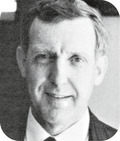
Rolland Parc.
A standing committee prepared for the election of officers at the first Annual General Meeting (AGM) the following year: Rolland Parc (France), Roger Grace (UK and Chairman of the Standing Committee), John Christiansen [Denmark and President of the Division of Coloproctology, Section of Surgery of the Union Européenne des Médicins Spécialistes (UEMS)], Jean‐Claude Givel (Switzerland), Hector Ortiz (Spain), Mario Pescatori (Italy), Rudolf Schiessel (Austria), Andrew Shorthouse (UK), Cor Baeten (Netherlands), Thorolf Hagar (Germany), John Nicholls (UK and Secretary of the Division of Coloproctology UEMS) and Lars Påhlman (Sweden). Werner Hohenberger (Germany) and Nick Carr (UK) joined later.
There was a commitment to work constructively with the ECCP [5] whilst recognizing the fundamental difference in the aims of the two organizations. Individual membership was the key to cohesion and achieving its aims. Indirect block membership through national associations was excluded. Various membership categories were created to allow the EACP to evolve as a multidisciplinary organization. Fundamental decisions were made to establish membership criteria to facilitate development of political influence, promote the specialty of coloproctology, influence training and clinical standards across Europe and promote international research. An important principle was that administrative costs had to be met by membership dues.
It was agreed that in future years the general members of the EACP would nominate Ordinary Members of Council but the Executive alone would recommend senior officers for ratification and election by the membership at the AGM. This served to prevent regional groups electing undemocratically selected candidates into senior positions [9].
First Annual Meeting 2000
The first scientific meeting and AGM were held in September 2000 in Versailles, with Rolland Parc as President and Andrew Shorthouse (UK) as Secretary (Table 2). The meeting focused on Crohn’s disease and included 16 presentations on its various aspects and a further 109 short paper presentations [9, 10].
Table 2.
ECCP and EACP 1984–2005 executive officers; Annual Meeting and AGM venues.
| Year | Society | Executive Officers | ||||
|---|---|---|---|---|---|---|
| ECCP Secretary General | Secretary | Treasurer | Programme | |||
| 1984–2001 | ECCP | M.‐C. Marti* | ||||
| 2001–2005 | ECCP | N.J. Haboubi* | ||||
| Venue | EACP President † | |||||
| 1999 | EACP | Paris | R. Parc | A.J. Shorthouse | M.C. Parker | R.J. Nicholls |
| 2000 | EACP | Versailles | J. Christiansen | " | " | " |
| 2001 | EACP | Maastricht | W. Hohenberger | " | " | " |
| 2002 | EACP | Erlangen | C. Baeten | " | " | " |
| 2003 | EACP | Barcelona | R.J. Nicholls | A. Mellgren | " | " |
| 2004 | EACP/ECCP | Geneva | H. Ortiz | " | " | " |
| 2005 | EACP/ECCP | Bologna | A. Dziki‡ | " | " | " |
ECCP Secretary General.
Year of election (overseeing the following year’s Annual Meeting).
A. Dziki elected Standing ESCP President September–December 2005 and ESCP President January–September 2006.
Andrew Shorthouse made an essential contribution in these initial years in establishing the EACP as a going concern at a time when its success was uncertain. He remained Secretary until 2003 when he handed over to Anders Mellgren (Sweden).
The Versailles meeting of 2000 was attended by 178 delegates and took place in a compact and inexpensive venue ideal for the numbers. It was a financial success, with a year‐end profit for the Association of €12 300. The scientific meeting was a novel in‐depth multidisciplinary symposium on Crohn’s disease [9, 10]. At the first AGM Executive Members and Ordinary Members of Council were elected and included John Christiansen (President), Werner Hohenberger (President Elect), Cor Baeten (President‐in‐Waiting), Andrew Shorthouse (Secretary), Nick Carr (Treasurer), Anders Mellgren (Assistant Secretary), Mike Parker (Assistant Treasurer) and Freddy Penninckx (Journal Representative). Other elected members of Council were Jean‐Claude Givel, Roger Grace, John Nicholls, Hector Ortiz, Lars Påhlman, Rudolf Schiessel, Mario Pescatori and Thorolf Hager (Fig. 4).
Figure 4.
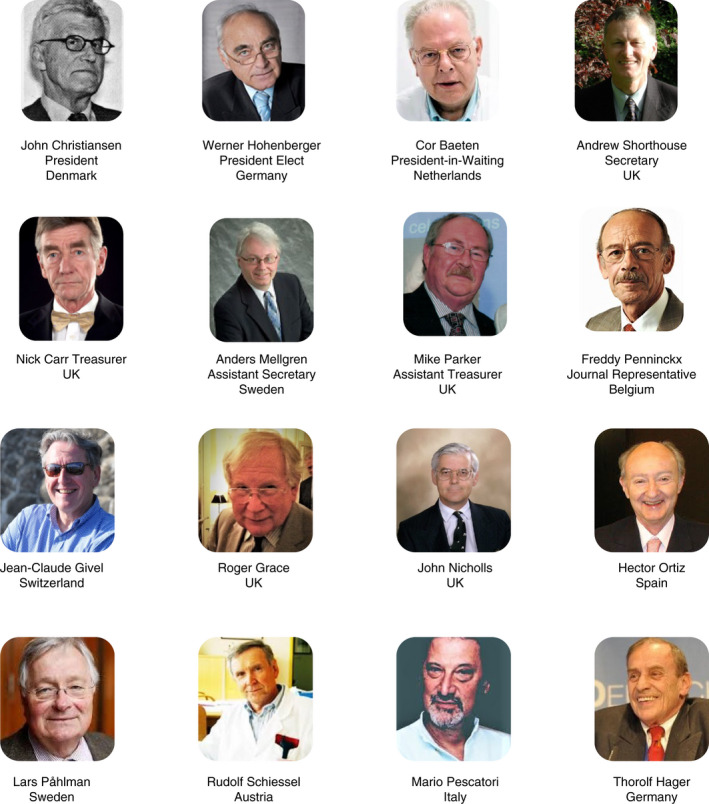
Executive Members and Ordinary Members of Council elected at the first EACP AGM, Versailles, September 2000.
The venue and Presidents of the further six Annual Meetings of the EACP are shown in Tables 2 and 3, which also include details of the committee structure. Membership categories were defined as Full, Honorary, Trainee, non‐European, Corporate, Honorary and Affiliate (e.g. nurses, scientists, technical and allied professions). Voting rights were limited to Full and Honorary Members, the former up to retirement or to the age of 70 years.
Table 3.
EACP committees, chairs and representatives 1999–2005.
| Year | Research | Website | Trustees | Journal* | UEMS* |
|---|---|---|---|---|---|
| 1999 | |||||
| 2000 | K. Matzel | A.J. Shorthouse | F. Penninckx | ||
| 2001 | " | " | " | L. Påhlman | |
| 2002 | L. Påhlman | " | " | " | " |
| 2003 | " | " | " | K. Matzel | " |
| 2004 | " | " | " | " | " |
| 2005 | " | " | " | " | " |
Journal and UEMS Representatives.
In 2001, on the suggestion of Bruno Cola (Italy) (Fig. 5) and to ensure fair distribution of the presidency, it was agreed to divide Europe into three geographical parts, Western, Central and Eastern, to allow each country to be represented in a fair and equitable manner. This gave all members a voice, especially those from East European and non‐European countries such as Israel.
Figure 5.
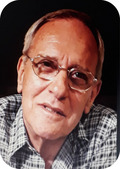
Bruno Cola.
Thus, Presidents rotated over a 3‐yearly cycle while the Secretary and Treasurer each served a minimum of 3 years on a staggered basis for continuity of management and administration. These officers were recommended for election by the Executive to Council and ratified by the membership at the AGM. An Assistant Secretary and Treasurer were also appointed to learn the elements of the post, prior to their own election as Secretary and Treasurer.
The Division of Coloproctology (UEMS)
In May 1997 the Section of Surgery of the UEMS approved the formation of the Division of Coloproctology, defining criteria for accreditation and certification in Europe [11] in response to a proposal submitted by John Christiansen and John Nicholls who became its first President and Secretary respectively. They invited the EACP to supply National Representatives to the Division to facilitate international communication with its grass‐roots membership.
After establishing a constitution, the Division set criteria for accreditation and certification to parallel board certification in the USA. It created the European Board of Surgical Qualification (EBSQ) (Coloproctology) diploma which was first awarded by examination in 1998 in Malmö, Sweden, with Helge Myrvold (Norway), Mario Pescatori (Italy), Manuel Devesa (Spain), Cor Baeten (Netherlands), John Christiansen (Denmark), Marc‐Claude Marti (Switzerland), John Nicholls (UK), Thorolf Hager (Germany) and Hector Ortiz (Spain) as examiners (Fig. 6) [11].
Figure 6.
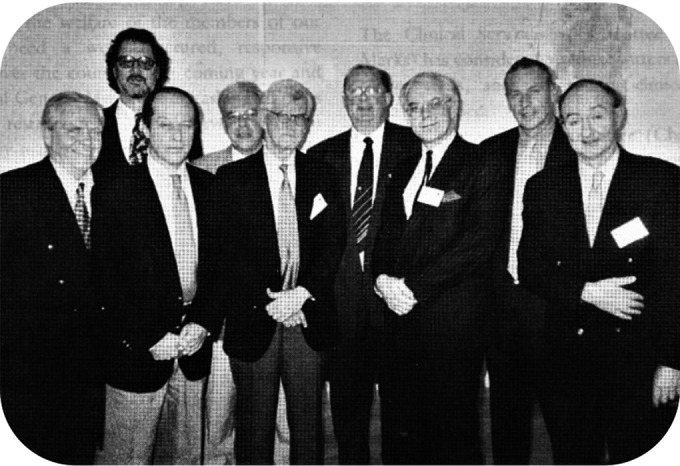
The examiners at the first EBSQ examination, Malmø, 1998. Left to right: Helge Myrvold, Mario Pescatori, Manuel Devesa, Cor Baeten, John Christiansen, Marc‐Claude Marti, John Nicholls, Thorolf Hager, Hector Ortiz.
An important function of the Division was to identify specialist coloproctology training units across Europe, defined as having at least two surgeons spending 75% or more of their time in colorectal surgery, having university affiliation and trainees with updated logbooks. Units were invited to apply to the Division for training unit recognition [11, 12, 13].
Close links with the Division were vital for the EACP to fulfil its aims of raising specialty clinical and training standards across Europe. To this end, the eventual establishment of an Education and Training Committee was important [6, 13].
John Christiansen and John Nicholls were both founding members of the EACP. The former served as President of the EACP in 2001 and the latter was appointed President in 2004 and Programme Chair in 2006. Lars Påhlman (Sweden) became the EACP representative on the Division in 2001 and its own Chair the following year on the retirement of John Christiansen, while Klaus Matzel (Germany) (Fig. 7) took over from John Nicholls. Thus, the officers and National Representatives on the Division of Coloproctology were all closely associated with the EACP and were ideally placed to support the EBSQ examination, training unit assessment and continued professional development. By 2006, there were 89 accredited units [14].
Figure 7.
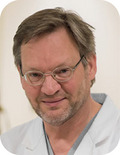
Klaus Matzel.
EACP and Colorectal Disease
In 1999, the EACP Founder Members adopted Colorectal Disease as its official journal. The Annual Scientific Meeting proceedings were published by the journal from 1999 as its reputation grew to become a leading international multidisciplinary publication. Freddy Penninckx (Belgium) was the Journal Representative on the EACP Council from 2000 to 2003 and was followed by Klaus Matzel.
Colorectal Disease was packaged as part of the annual membership subscription. In 2003, John Nicholls, Editor, successfully negotiated the publication of abstracts and peer‐reviewed papers by invited speakers in addition to editorial comment at no cost to the EACP.
The ECCP had already affiliated with Techniques in Coloproctology. Prior to amalgamation to form the ESCP, both Councils agreed to adopt a journal that would be optional to members but not part of the subscription fee. Despite some ECCP objections to ownership of Colorectal Disease by the ACPGBI, it was formally adopted by the ESCP in 2006.
Administration and company status
Initially the EACP administration was overseen by Anne O’Mara, the ACPGBI administrator, on an ad hoc basis, but shortly before the first Annual Meeting in 1999 Lindsey Whitehouse (Fig. 8), of the Edinburgh‐based company Integrity International Events Ltd (‘Integrity’), was interviewed by Andrew Shorthouse and Nick Carr at the 1999 ACPGBI meeting in Southport and was appointed to manage the EACP membership database, with a view to taking on the eventual organization of conferences and meetings from 2002 onwards. Her role was of crucial importance to the development of the EACP and subsequently the ESCP. Adopting the ACPGBI company model, McClure Naismith (solicitors) and Whitelaw Wells (accountants and auditors) in Edinburgh were appointed to oversee incorporation of the EACP as a Company Limited by Guarantee in March 2000 with recognition by the UK Inland Revenue as a Scottish charity and company. Continuity of centralized administration and consistency of event management from that time were efficient and cost‐effective.
Figure 8.
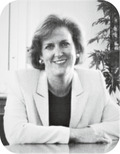
Lindsey Whitehouse, CEO Integrity International Events Ltd.
Financial prudence was necessary from the outset, with secretarial and administration overheads to be met from annual membership fees. A start‐up loan of €7700 was granted by the ACPGBI.
Expanding into major conference venues
Major challenges for the EACP, especially in its early days, included balancing the considerable cost of expansion into major conference venues with low numbers of paid‐up members paying affordable registration fees. It was necessary to compete with other organizations seeking support from industry, to establish a sufficiently healthy capital base to offset a potentially huge financial loss from a failed congress.
Fortunately, there was early generous support offered by the following companies: B Braun Medical, Blackwell Science, Ethicon Endo Surgery, Tyco Healthcare, ML Laboratories, Astra Zeneca and Schering Plough.
It was a matter of relief to learn that incorporation as a Company Limited by Guarantee absolved the Executive and membership of any personal liability in the event of a failed meeting and potential insolvency, e.g. from terrorism or natural disaster. A financial commitment to major conference venues at that time was somewhat speculative and risky but essential for expansion.
A Board of Trustees (Company Directors) was appointed to ensure that the EACP was compliant with company law and its charitable objectives. Its members included Andrew Shorthouse (UK), Chair from 2000 to 2005, John Christiansen (Denmark), Joe Deasy (Republic of Ireland), Roger Grace (UK), Werner Hohenberger (Germany), Roland Parc (France), John Nicholls (UK), Lars Påhlman (Sweden), Mario Pescatori (Italy), and subsequently Nick Carr (UK) who was Chair after 2005, Leif Hultén (Sweden), Anders Mellgren (Sweden) and Mike Parker (UK) [9].
Committees
There were few committees during the early years of the Association (Tables 2 and 3). The Programme Committee, chaired by John Nicholls, was established immediately to organize the Annual Scientific Meeting. A Research and Audit Committee was formed in 2002 under the chairmanship of Lars Påhlman. A website, established in 2000, was expanded under the guidance of Klaus Matzel, to facilitate online applications for membership and conference registration from 2004.
National Representatives
National Representatives were appointed to promote coloproctology as a specialty, recruit members locally and organize election of their successors, but most importantly they provided a network of communication between the EACP Council and local grass‐roots membership. They were elected on a 3‐yearly rolling basis from 2001 onwards to provide continuity of Council membership [15].
Precarious finances
The second Annual Scientific Meeting and AGM, held in 2001 at the end of John Christiansen’s presidency, was attended by 220 delegates and hosted by Cor Baeten in Maastricht [16, 17]. The theme was ‘Quality of Life and Function after Rectal Surgery’. Selected abstracts were presented by trainees in each session. A nurses’ symposium was introduced and the EBSQ (Coloproctology) Part II examination was held. Although finances remained tight, the venue was more expensive, but the Dutch government agreed to underwrite 75% of any meeting losses, whilst the EACP retained 90% of the profits and the remaining 10% was allocated for local costs [15].
Despite a small (12%) increase in membership, many Founder Members had failed to join formally, perhaps because in many parts of Europe general surgeons still managed around 80% of colorectal surgery.
The third scientific meeting in 2002 was hosted by Werner Hohenberger in Erlangen, with the theme of ‘Trends and Controversies in the Multidisciplinary Management of Rectal Cancer’. It was not a financial success despite its excellent scientific quality. Only just over 200 delegates attended, failing to meet the break‐even target of 300. Access to Erlangen was a problem. Speaker expenses of around €40 000 were disproportionately high. An overall loss of €30 000 was partially offset by a value added tax (VAT) refund of €13 170. EACP finances were now precarious, and reserves stood at only €3740. A Welsh Office grant of £22 500 (€35 865 equivalent in 2001) over 3 years, organized by the Treasurer Nick Carr, was crucial to survival.
At the 2002 year‐end, the combined losses of the Erlangen and Maastricht meetings were €27 692, leaving a capital reserve deficit of €5229. Although membership fees were frozen to encourage recruitment, there were still only 216 members. Despite this the initiation fee of €48 was abolished the following year to encourage new members. It was therefore a very difficult time financially. The EACP was struggling to balance large conference venue costs with income from limited membership fees and conference registrations. It depended heavily on support from industry without which it may not have survived. There was intense competition from other scientific organizations in Europe for a limited pool of funding from industry but, despite this, the EACP received sufficient support which was gratefully acknowledged at the time.
The turn around
A major concern for the Trustees was containment of expenses. This was addressed in a number of ways. Membership fees needed to cover administrative costs. Invited speakers from the USA and elsewhere from outside Europe were limited to a maximum of two business class tickets with hotel accommodation. Non‐member European speakers were granted economy travel and hotel accommodation, and EACP members invited to speak or chair sessions were asked to cover their own expenses. It was necessary to increase the membership and an important initiative in this respect, proposed by the representatives of Poland, the Czech Republic and Hungary, was a 2‐year trainee‐equivalent reduction in membership and conference rates for participants from East and Central Europe, with an option to subscribe to Colorectal Disease at membership‐discounted rates.
The EACP reached solvency by 2003 with reserves at €38 276, mainly due to an increase in membership, conference rate initiatives and continued support from industry. The positive financial predictions made earlier in the year, however, were heavily dependent on the success or otherwise of the fourth Annual Meeting to be held in Sitges (Spain) in September 2003.
In planning the Sitges meeting, targeting and incentives for delegates to become members were required. Corporate membership was mutually beneficial and produced a regular income stream without compromising standards. The potential for bias arising from company‐sponsored topics in the scientific programme was avoided by insisting upon evidence‐based presentations.
The thematic style of the meetings in Versailles, Maastricht and Erlangen had been novel and academically exciting but the in‐depth focus of a single topic made no financial sense and was abandoned in favour of a more traditional and pragmatic programme covering multidisciplinary ‘state of the art’ subjects over the entire coloproctology spectrum. This drew a much wider audience, attracted membership and sponsorship, and generated more income.
With these tactical changes, the fourth EACP Annual Meeting in Sitges in 2003 attracted over 500 delegates. The more generic theme of ‘Complications in Colorectal Surgery’ was highly successful and far exceeded budget predictions, resulting in a surplus of €67 500. The Mediterranean venue may have been an additional factor for the success of the meeting, not least for delegates from northern Europe, and the addition of CCTV transmission and workshops widened the attraction. Year‐end capital reserves exceeded €100 000 for the first time. The ACPGBI loan was fully repaid. The financial position of the EACP by the end of 2003 was by this time secure.
Chapter 2
Merger of the ECCP and EACP 2004–2005 and creation of the European Society of Coloproctology
Initial steps
By 2003 there was a growing feeling amongst members of both organizations that they should amalgamate into a single society [13, 18, 19]. A concentrated effort was made in the EACP to start negotiations with the ECCP (Fig. 9) for an eventual merger in 2006. The first step in 2004 was a joint meeting of the two organizations in Geneva.
Figure 9.
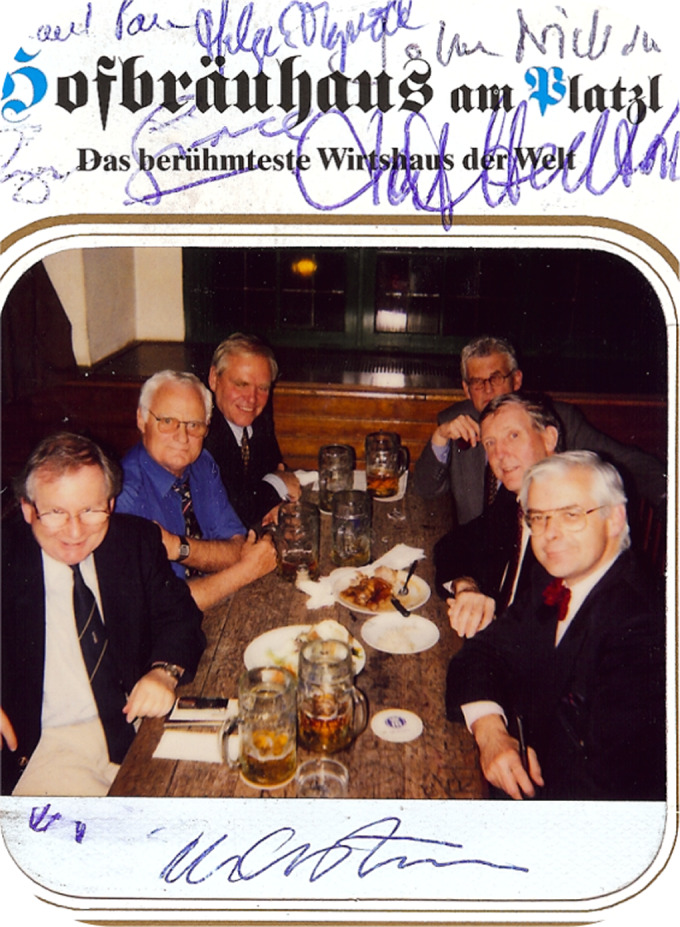
ECCP and EACP representatives at the ECCP meeting, Munich 1999. Left to right: Roger Grace, Leif Hultén, Helge Myrvold, John Christiansen, Rolland Parc, John Nicholls.
A decade earlier, the ACPGBI and the Section of Coloproctology of the Royal Society of Medicine, London, had been invited to host the biennial ECCP congress in Edinburgh in 1997, as part of the ACPGBI’s Annual Scientific Meeting. The ECCP sought input into the programme whilst delegating financial arrangements to the hosts. Unfortunately, the ECCP Council was disenfranchised owing to the release of the final programme before they could endorse it. It was reasonably claimed that the programme was disproportionately biased in favour of the UK. Despite unease, there was a significant Central and East European presence. This further encouraged the idea of forming a new European society despite some souring of relations between the ECCP and ACPGBI, which became a factor behind some difficult ESCP merger discussions over the following decade.
Many Central and East European societies were staunch supporters of the ECCP, and antagonistic to the EACP, which might have been regarded as a threat to corporate sponsorship available for ECCP meetings. Poor support for ECCP meetings by some Western surgeons was rightly criticised. Furthermore, the high cost of EACP membership and conference registration for East and West Europeans at a time of economic difficulty after the collapse of the Soviet Union, was a disincentive to join. Many felt that the EACP was biased towards the northwestern part of Europe but, on the other hand, many leaders in the field at that time came from there. In particular, in 1998, the German Coloproctological Society maintained that the EACP would lead to ‘further dissociation of the specialty [of gastrointestinal and hepatic surgery] and … confrontation with the ECCP’ [Personal Communication].
At the 1999 EACP meeting in Paris, Michael Keighley emphasized the importance of amalgamation with the ECCP, which he felt had made an important contribution to the development of European coloproctology, establishing a sense of unity, mainly amongst Central and East European surgeons. However, its predominant role was educational and not specialist training, for which a strong society based on individual membership was necessary to match the specialty recognition and accreditation long established in the USA.
The publication of the EACP constitution in 1998 injected a degree of democracy into the ECCP which then revised its own constitution to mirror that of the EACP [18, 19]. However, the ECCP continued to collect membership fees from its affiliated national societies to secure its income stream, but at the same time claimed there was no substantial difference between themselves and the EACP and maintained that EACP expansion would be divisive. It was even suggested that the EACP might become a section of the ECCP. The EACP countered that the ECCP remained undemocratic and therefore was unable to influence the EBSQ (Coloproctology) Part II diploma.
Despite these differences, the sides had moved sufficiently closer by 2002 to begin merger negotiations. Their constitutions were by this time fundamentally similar and, increasingly, they shared the same Council members. There was potential benefit if both organizations could work together [6, 19].
The EACP remained committed to the concept of a single European society with equal representation across the regions. A good relationship with the ECCP was therefore an important priority, due to its level of Central and Eastern European support. From the outset the EACP had adopted a pragmatic approach to work closely but in parallel with the ECCP until it had become firmly established and financially secure. Unification was the ideal but, should the ECCP wish to remain independent, then there would need to be coexistence. It was acknowledged that over time one might become dominant with absorption of the other. Their differences were compatible; the ECCP was a confederation of national societies and primarily concerned with education through its biennial meetings whereas the EACP was more politically motivated, aiming for training unit recognition and accreditation.
Marc‐Claude Marti stressed that conflict was undesirable and brought an EACP representative onto the ECCP Council, proposing that the ECCP Prague meeting in 2001 might be held jointly with the EACP. However, there was insufficient capacity for EACP participation in the main body of the meeting, and EACP members were therefore invited as individuals to participate as speakers or chairmen.
Merger working group
Najib Haboubi succeeded Marc‐Claude Marti as Secretary‐General of the ECCP in 2001 and was a major catalyst for the merger. The EACP and ECCP held parallel Council meetings in Erlangen in 2002, with unanimous agreement that negotiations should formally begin towards amalgamation to create the ESCP. The ECCP stopped planning beyond 2005 on the basis that the newly merged organization would have a meeting in Central Europe.
A working group convened in 2003, with equal representation from both Councils and a mandate to explore how collaboration and amalgamation might proceed. The group comprised Cor Baeten (EACP President), Bruno Cola (ECCP), Adam Dziki (EACP) from Poland, Jaroslav Faltyn (ECCP) from the Czech Republic, Najib Haboubi (Secretary General ECCP), Jens Kirsch (Treasurer ECCP), Anders Mellgren (EACP Secretary), John Nicholls (EACP President‐elect), Hector Ortiz (EACP), Mike Parker (Treasurer EACP) and Andrew Shorthouse (Chairman and outgoing EACP Secretary). Ioannis Karaitianos (ECCP President) was also an original member of the group which was expanded to include Tomas Skřička (ECCP) from the Czech Republic, Dainius Pavalkis (ECCP) from Lithuania and Yury Shelygin (ECCP) from Russia (Fig. 10).
Figure 10.
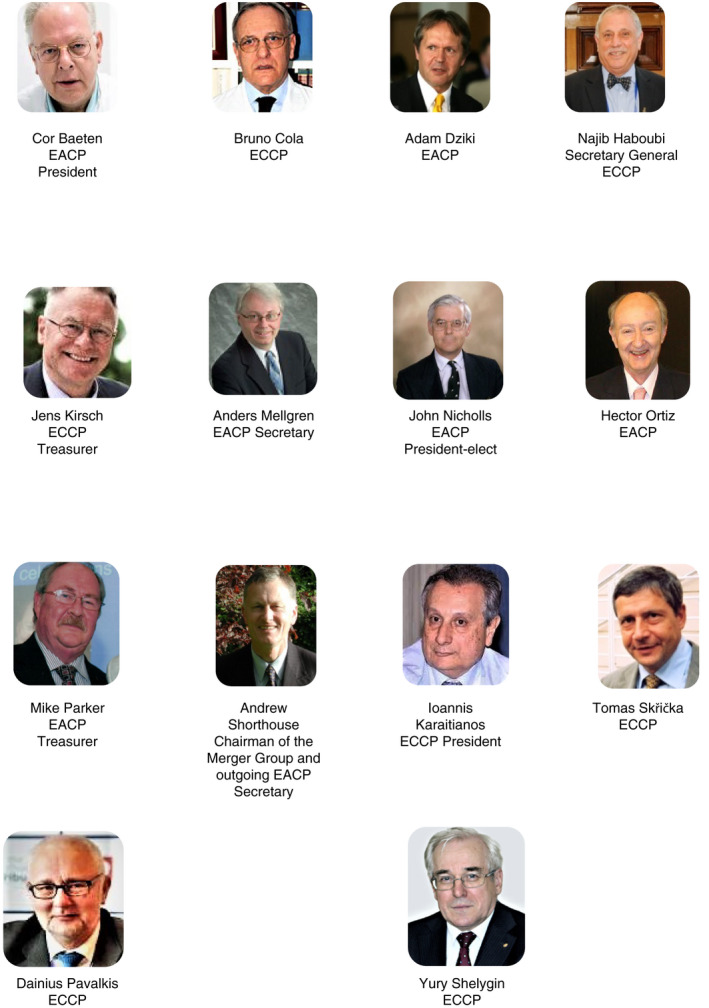
Members of the ECCP/EACP Merger Working Group 2003.
The Working Group met regularly from 2003. Both Councils agreed that negotiations towards a merger should continue. Several Central and Eastern European ECCP members abstained due to a perceived existential threat to the newly established Italian‐driven European Club of Coloproctology, launched in Lithuania the previous year.
In view of the sensitivities, the Working Group was expanded to include more Eastern and Central European members and recommended that, on its formation, the first President of the ESCP should be from Eastern or Central Europe in support of the new society’s commitment to geographical equivalence. Adam Dziki (Fig. 10) was elected on this basis in addition to his significant contribution to the merger process and his high standing particularly in Eastern and Central Europe.
There were considerable difficulties regarding the appointment of administrators, company details, legal representatives, charitable status, and where they should all be based. There were ideological arguments in favour of a Central European base but set against this there were practical and financial reasons for retaining Edinburgh. English was adopted as the official language although provoking the comment from members of Council that ‘there is an evident handicap for Continentals to express themselves perfectly. So no wonder that we all may be “lost in translation” at least from time to time…’ [1].
Anders Mellgren, the EACP Secretary, had an important coordinating role over the merger period, working effectively and seamlessly from Minnesota towards the end of his term.
The Merger Group agreed that after amalgamation the ESCP should adopt a journal. The proposal for Colorectal Disease was rejected by the ECCP in favour of Techniques in Coloproctology. Fresh proposals from different publishers would therefore be required after amalgamation.
Completing the merger
In a fresh spirit of cooperation in 2003, both Councils agreed a series of joint ventures. Ioannis Karaitianos (Fig. 10), who was the ECCP President at that time, invited the EACP to organize a plenary session at the ECCP meeting in Athens. The EACP returned the compliment by inviting the ECCP to participate in its meeting in Sitges (Spain) in September 2003. Participation by the ECCP continued at the EACP meetings in Geneva (2004) and Bologna (2005), during the presidencies of John Nicholls and Bruno Cola.
Joint EACP/ECCP symposia were held in 2004 at the International Society of University Colon and Rectal Surgeons in Budapest and the United European Gastroenterology Federation (UEGF) in Prague. EACP and ECCP Council meetings were hosted at respective scientific meetings.
It was a sound assumption that by 2005 there would be de facto a single organization. The expansion of the European Union into Eastern and Central Europe during the 1980s and 1990s must have been a factor which catalysed negotiations and promoted a sense of continental unity.
A new constitution, prepared by Adam Dziki, Najib Haboubi, Anders Mellgren, Tomas Skřička and Andrew Shorthouse, was accepted unanimously by both Councils in Geneva in 2004, with a mandate to conduct the election of a Standing Council, set up a company and appoint Integrity International Events Ltd to administer the ESCP for 3 years after its inauguration.
Provision for equal opportunity for Central and Eastern Europeans on the ESCP Council created a greater sense of ownership, with regional rotation into key executive posts. Sensitivities lingered about where the new administration, lawyers, auditors and accountants should be based and reassurance was given that the influence of the ACPGBI would gradually decline with successive rotation of executives and presidents through the regions.
The EACP from the outset was a UK‐based company as a matter of convenience. The UK Secretary and Treasurer had mostly driven its day‐to‐day development, negotiating with Integrity to establish the EACP as a company in Edinburgh. The potential difficulties of establishing alternative working relationships with new European administrators, lawyers and accountants were not to be underestimated. Of overriding importance was that a new administration would have to be appointed on merit and be cost‐beneficial, irrespective of nationality.
Joint Meeting of ECCP and EACP in Bologna, 2005
By 2005 there was full support for the creation of the ESCP from all European countries. The Central European Coloproctology Club was dissolved, leaving the way open for a single European organization to facilitate training unit recognition and accreditation and certification, promote international audit and research, enhance relations with the American Society of Colon and Rectal Surgeons (ASCRS) and create links with the European Union. It would also benefit from reduced competition for pharmaceutical and technological support from industry. Agreement to amalgamate was finally reached and in early 2005 Andrew Shorthouse, the Chairman of the ECCP/EACP Merger Committee, was able to announce the agreement to merge later in the year to coincide with the second joint EACP/ECCP scientific meeting in Bologna, hosted by the ECCP President Bruno Cola [20, 21]. Such a move had great potential to strengthen European coloproctology [20]. The choice of Bologna had symbolic significance as the first ECCP meeting had taken place there 19 years earlier [4].
The meeting was hugely successful, buoyed on a wave of goodwill from each side with sessions and lectures divided equally between the two organizations. It also coincided with the foundation meeting in parallel of the Italian Society of Colorectal Surgery [Società Italiana di Chirurgia Colorettale (SICCR)].
The founders of the EACP, together with key members of the ECCP, were visionary in creating a single united European coloproctological society, able to collaborate with the Division of Coloproctology (UEMS) to establish criteria for full specialty recognition, accreditation and certification throughout Europe.
The logos of the ECCP and EACP were combined to represent the new society (Fig. 11).
Figure 11.

Logos of the ECCP, EACP and ESCP (2006–2010).
Chapter 3
Formation of the European Society of Coloproctology in 2006
Difficult times 2006–2009
The history of the ESCP spans the years 2006–2020. During this period there was initial disagreement on several strategic questions, the most important of which concerned the location of its management. This was resolved through discussion at the Third Annual Meeting held in Prague in 2009. From then on, the Society developed an increasing range of services for its members. It created scientific and educational committees and drew ever closer to the Division of Coloproctology of the UEMS. Through generous support from industry, its financial position became secure and the meetings attracted increasing numbers of participants. Sections for trainees and nurses were formed.
The new society: transfer from ECCP and EACP membership
The ESCP was finally established on 1 January 2006 and became the unified voice of European coloproctology, offering a focus for the speciality within a huge population base, in countries where there were diverse styles of training and practice [21, 22]. It was agreed that membership should be individual and no longer society‐based. Integrity International Events Limited (www.integrity‐events.com) continued with administration, conference organization and logistics. Amalgamation was seamless for existing EACP members with automatic membership transfer and reduced annual membership fees (€60), which covered administrative costs. Initiation fees were abolished. Rates of €42 for colorectal trainees, scientists and nurses per annum were affordable. Many ECCP members were from Eastern and Central Europe and joining the ESCP was encouraged by setting fees at trainee rates. This was only sustainable in the longer term by achieving a critical membership mass. In 2007, Eastern and Central European Council members suggested parity of membership fees and after incremental increases this was achieved by 2010 (Fig. 12; Table 4). Preferential conference rates were available for paid‐up members as an inducement for others to join the Society and to address the imbalance between the number of members and delegates attending the meetings.
Figure 12.
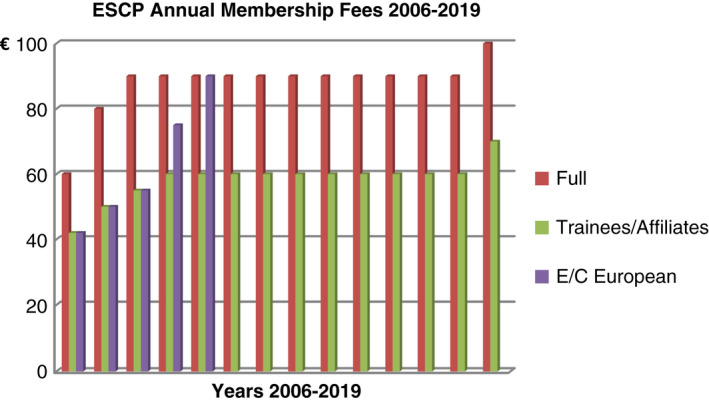
Annual membership fees (Full, Trainees and Affiliates) (Eastern and Central European members reached parity in 2010).
Table 4.
Membership fees 2006–2019.
| Year | Full | Trainees/affiliates | E/C European |
|---|---|---|---|
| € | € | € | |
| 2006 | 60 | 42 | 42 |
| 2007 | 80 | 50 | 50 |
| 2008 | 90 | 55 | 55 |
| 2009 | 90 | 60 | 75 |
| 2010 | 90 | 60 | 90 |
| 2011 | 90 | 60 | n/a |
| 2012 | 90 | 60 | n/a |
| 2013 | 90 | 60 | n/a |
| 2014 | 90 | 60 | n/a |
| 2015 | 90 | 60 | n/a |
| 2016 | 90 | 60 | n/a |
| 2017 | 90 | 60 | n/a |
| 2018 | 90 | 60 | n/a |
| 2019* | 100 | 70 | n/a |
Three years' single payment: €270 full; €190 trainees, affiliates and Eastern/Central Europeans to 2010.
Local organizers of the Annual Meeting were not permitted to share any of the profits from meetings but, importantly, they were absolved from personal financial risk arising from a failed meeting. This ensured tight central control of finance.
There were financial difficulties initially. Although the dissolution of the ECCP and the EACP to create the ESCP realized combined assets of €135 000, EACP capital reserves had fallen by €13 000 to €31 683 due to the legal cost of setting up the ESCP. The second joint meeting of the EACP and ECCP in Bologna in 2005 was expensive and produced a surplus of just €3122. Membership fees for the newly formed ESCP needed to be increased by 20%–25% the following year.
Live surgery satellite costs were a major expense. Corporate support for the recording of conference sessions and more prepared edited videos were the way forward. A cost template was introduced by Integrity to facilitate a more accurate prediction of comparative conference venue costs (Appendix S3).
The EACP had previously devised three vertical European regional divisions (Western, Central and Eastern) to achieve equitable geographical representation and influence on the Council. This formed the basis of rotation of the President and other Council posts between the regions. The Secretary and Treasurer were recommended by the Executive to Council for ratification and election on merit to maintain continuity. The same system was adopted by the ESCP in 2006.
Executive and non‐executive members formed a two‐tier Council structure. The Executive evolved policy, ran day‐to‐day business and made recommendations to Council for ratification by the membership at the AGM [23].
The ESCP Executive Officers from 2006 to 2020 and the years and locations of Annual Meetings are shown in Table 5. The current ESCP committee structure is shown in Fig. 13 and the Committees with their chairs in Tables 6 and 7. The financial surplus from each Annual Meeting, year‐end capital reserves, and delegate and membership numbers are shown in Table 8. Trends between 2006 and 2020 are illustrated in Figs 14, 15, 16, 17. The scientific programmes for each meeting can be found on the webpage of the ESCP [24] (Appendix S1).
Table 5.
Presidents, Secretaries, Treasurers and Chairs of the Programme Committee 2006–2020.
| Venue | Year | Senior Executive Officers | |||
|---|---|---|---|---|---|
| President | Secretary | Treasurer | Programme Chair | ||
| Lisbon | 2006 | A. Dziki* 2005–06 | A. Mellgren* | M.C. Parker* | R.J. Nicholls* |
| Valetta | 2007 | L. Påhlman 2006–07 | " | " | " |
| Nantes | 2008 | A.J. Shorthouse 2007–08 | R. O'Connell | " | " |
| Prague | 2009 | T. Skřička 2008–09 | " | " | E. Tiret |
| Sorrento | 2010 | G. Romano 2009–10 | " | T. Schiedeck | " |
| Copenhagen | 2011 | F. Penninckx 2010–11 | P. Dawson | " | " |
| Vienna | 2012 | Z. Krivokapic 2011–12 | " | " | D. Altomare |
| Belgrade | 2013 | S. Laurberg 2012–13 | " | P.‐A. Lehur | " |
| Barcelona | 2014 | R. O'Connell 2013–14 | E. Espin Basany | " | " |
| Dublin | 2015 | Y. Shelygin 2014–15 | " | " | A. Martling |
| Milan | 2016 | S. Post 2015–16 | " | F. La Torre | " |
| Berlin | 2017 | E. Tiret 2016–17 | G. Möslein | " | " |
| Nice | 2018 | E. Gecim 2017–18 | " | " | D. Winter |
| Vienna | 2019† | P. Nilsson 2018–19 | " | M. Pera | " |
| Vilnius | 2020 | W. Bemelman 2019–20 | A. Spinelli | " | " |
Senior ESCP officers elected in September 2005 in Bologna, moving to substantive posts 1 January 2006.
E. Xynos and K. Matzel elected President‐in‐Waiting and President‐Elect respectively in 2019.
Figure 13.
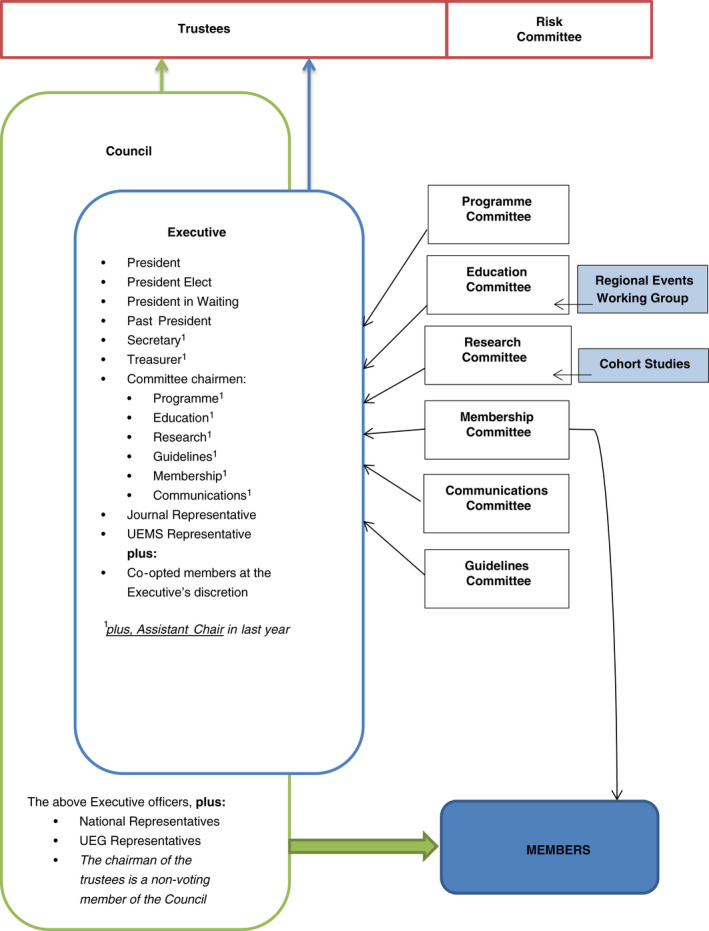
ESCP Committee structure ‘Organogram’ in 2020.
Table 6.
Committee chairs 2006–2020 and year of election at the AGM.
| Year | Education* | UEMS† | Research* | Membership* | Journal† |
|---|---|---|---|---|---|
| 2006 | K. Matzel | N. Haboubi | |||
| 2007 | " | " | |||
| 2008 | L. Påhlman | L. Påhlman | S. Laurberg | S. Post | " |
| 2009 | " | " | " | " | " |
| 2010 | " | " | " | " | " |
| 2011 | " | " | " | " | " |
| 2012 | K. Matzel | K. Matzel | D. Morton | " | " |
| 2013 | " | " | " | " | " |
| 2014 | " | " | " | E. Gecim | " |
| 2015 | " | D. Hahnloser | " | " | P. Dawson |
| 2016 | " | " | " | M. Machado | " |
| 2017 | " | " | " | " | " |
| 2018 | D. Hahnloser | D. Zimmerman | " | " | B. Singh |
| 2019 | " | " | C. Knowles | R. Scherer | " |
| 2020 | " | " | " | " | " |
Chairs* and representatives† elected at September AGM.
Table 7.
Committee chairs 2006–2020 and year of election at AGM.
| Year* | Website† | External relations† | Guidelines | Young ESCP | Trustees |
|---|---|---|---|---|---|
| Communications † | |||||
| 2006 | T. Irwin | J. Kirsch | |||
| 2007 | " | " | |||
| 2008 | D. Bartolo | H. Ortiz | |||
| 2009 | " | " | |||
| 2010 | M. Kassai | S. Laurberg | " | ||
| 2011 | " | " | " | ||
| 2012 | " | " | " | ||
| 2013 | " | P. Nilsson | S. Achkasov | ||
| 2014 | J. Orhalmi§ | " | " | ||
| 2015 | " | " | C. Vaizey | G. Romano | |
| 2016 | P. Nilsson | " | " | ||
| 2017 | P. Christensen | " | M. Frasson | " | |
| 2018 | " | " | " | " | |
| 2019 | R. Brady | " | " | " | |
| 2020 | " | S. Breukink‡ | " | " | |
Chairs elected at September AGM.
External Relations and Website Committees combined in 2015 to form Communications Committee, formalized in 2016.
Assistant Guidelines Chair: new Executive Officer position from 2019.
J. Orhalmi demits September 2020.
Table 8.
Finances, Annual Meeting delegates and members 2006–2019.
| Year | Venue | Meeting surplus € | Capital reserves € | Delegates, n | Membership | ||
|---|---|---|---|---|---|---|---|
| Total, n | ESCP nations | Other nations | |||||
| 2006 | Lisbon | 16 058 | 31 683 | 565 | 279 | 258 | 21 |
| 2007 | Malta | 53 000 | 136 542 | 689 | 365 | 344 | 21 |
| 2008 | Nantes | 60 440 | 250 000 | 730 | 567 | 527 | 40 |
| 2009 | Prague | 161 132 | 391 000 | 901 | 646 | 594 | 52 |
| 2010 | Sorrento | 36 114 | 512 000 | 965 | 745 | 686 | 59 |
| 2011 | Copenhagen | 86 665 | 609 000 | 787 | 726 | 670 | 56 |
| 2012 | Vienna | 136 400 | 694 000 | 1143 | 721 | 642 | 79 |
| 2013 | Belgrade | 212 200 | 656 102 | 1016 | 894 | 826 | 68 |
| 2014 | Barcelona | 280 000 | 982 472 | 1340 | 840 | 739 | 101 |
| 2015 | Dublin | 350 000 | 1 208 822 | 1393 | 1137 | 989 | 150 |
| 2016 | Milan* | 17 450 | 853 742 | 1388 | 1165 | 1018 | 147 |
| 2017 | Berlin | 166 850 | 758 873 | 1679 | 1384 | 1211 | 173 |
| 2018 | Nice | 307 818 | 935 846 | 1882 | 1800 | 1531 | 269 |
| 2019 | Vienna | † | † | 1808 | 2004‡ | 1711 | 293 |
Year‐end 2013–2019 figures verified by Integrity records.
2006–2012 data from AGM reports and other archival records; Integrity do not retain financial records before 2012.
Year‐end negative capital reserves and low meeting surplus in 2016 included €91 100 penalties from Istanbul cancellation, member resignations from Turkey and disbursement allocated to investment in Research Manager, education committee fellowship programme, communications and face‐to‐face committee meetings.
Financial reconciliation figures unavailable (January 2020).
As of July 2019.
Figure 14.
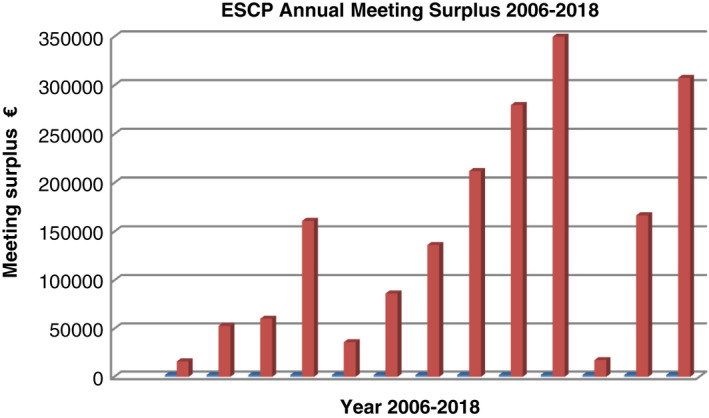
Annual Meeting surplus 2006–2018 (€).
Figure 15.
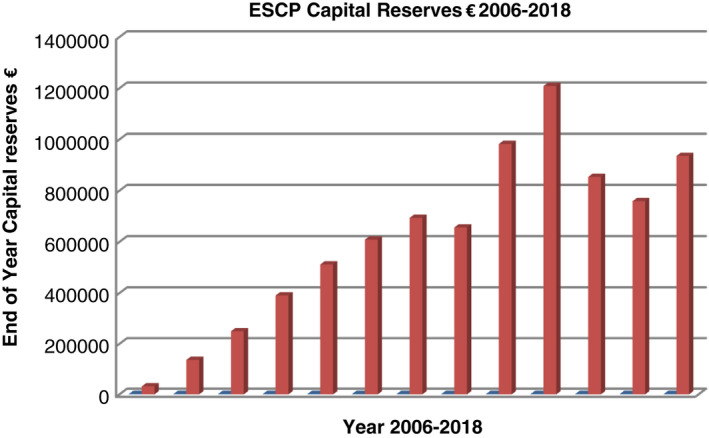
ESCP year‐end capital reserves 2006–18 (€).
Figure 16.
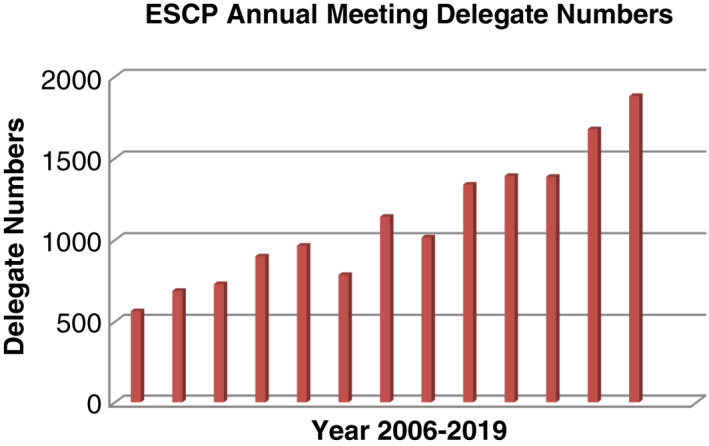
Annual Meeting delegate numbers 2006–19.
Figure 17.
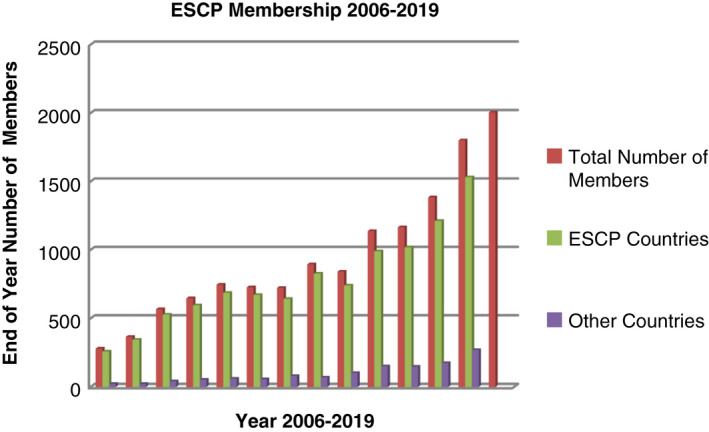
ESCP membership numbers 2006–2019.
The details of membership, finance, administration and committee structure are shown on the ESCP website for each year from 2007 to 2019 in the reports of the AGM [25] (Appendix S2). The Presidents of the ESCP from 2006 to 2020 are shown in Fig. 18.
Figure 18.
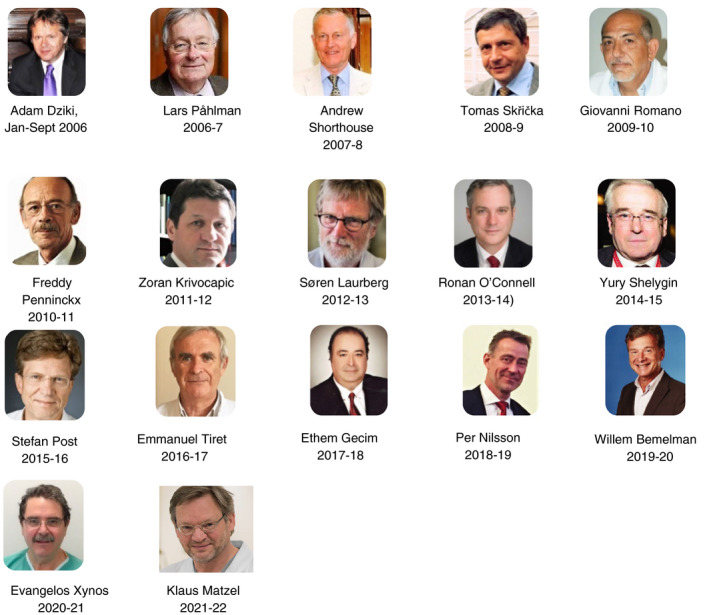
ESCP Presidents 2006–2022.
The early years 2006–2009
ESCP Annual Meetings
The minutes of each AGM are referred to alphabetically in the text from (a) to (n) as shown in Appendix S2.
Lisbon 2006
President Adam Dziki (Poland) www.escp.eu.com/images/pdf/final_program/ESCP‐Lisbon‐2006‐final‐programme.pdf
The inaugural Annual Meeting of the ESCP was held in Lisbon in September 2006 with Adam Dziki as President (Fig. 18), Anders Mellgren as Secretary (Fig. 19) and John Nicholls as Chair of the Programme Committee (Fig. 20). Core subject courses were introduced and proved very popular but, despite the inducement of lower registration fees, only 279 signed‐up members attended from a total of 565 delegates. Fortunately, secretariat costs were covered by membership income. The meeting itself was profitable, largely due to a later VAT reclaim, but the live streaming link to Coimbra was prohibitively expensive. It was clear that in future years there would be a need for more central control of conference expenditure (Appendix S3).
Figure 19.
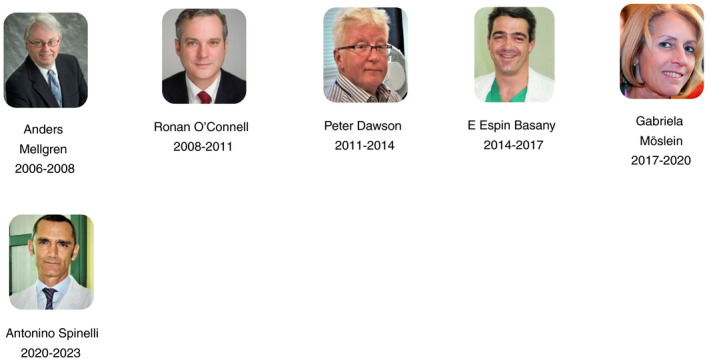
ESCP Secretaries 2006–2020.
Figure 20.

ESCP Programme Committee Chairs 2006–2020.
Mike Parker, the ESCP Treasurer (Fig. 21), and Lindsey Whitehouse had established excellent relations with the pharmaceutical industry and instrument manufacturers, often at executive level. These organizations supported the Annual Meetings and other ventures such as training courses and fellowships [25] (a) (Appendix S2 . Without their vital contribution, the ESCP might not have survived. At the first AGM (Appendix S3) Adam Dziki, having become Immediate Past President, gave a report of his term of office. The elected Executive Members included Lars Påhlman (President), Andrew Shorthouse (President‐Elect), Tomas Skřička (President‐in‐Waiting), Anders Mellgren (Secretary), Mike Parker (Treasurer), John Nicholls (Programme Committee), Najib Haboubi (Journal Representative), Klaus Matzel (representative of the Division of Coloproctology UEMS and also serving on the Division), Terry Irwin (Website Committee) and Jens Kirsch (Trustees’ Committee) (Fig. 22). A separate Board of nine Trustees (company directors), with representation from the regional division of Western, Central and Eastern Europe, was responsible for overseeing company finance and administration. This allowed the Executive to concentrate on the Annual Meeting and essential day‐to‐day matters. A relationship with the ASCRS was quickly established [23]. From 2008, the ESCP became an equal partner with the ACPGBI in the Tripartite Colorectal Meeting, a collaboration of the American, Australasian, British and Irish colorectal surgical societies [26].
Figure 21.

ESCP Treasurers 2006–2020.
Figure 22.
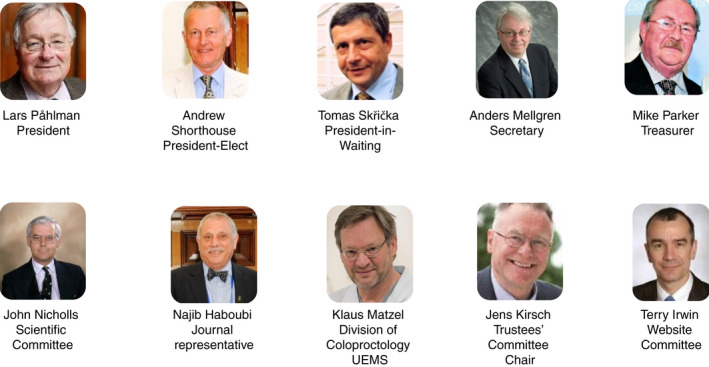
Executive Members elected at the first AGM in Lisbon 2006.
Malta 2007
President Lars Påhlman (Sweden) www.escp.eu.com/images/pdf/final_program/ESCP‐Malta‐2007‐final‐programme.pdf
Malta, the venue for the second Annual Meeting (b), attracted almost 700 delegates. Despite conference registration incentives, the number of members remained stagnant and low (Figs 16 and 17) (Tables 4 and 8). Edited operative videos in Malta were cost‐ and time‐efficient, allowing more free paper and oral poster presentations. ‘Tips and Tricks’ and new technologies were featured. Pre‐meeting core subject lectures continued, and company‐sponsored satellite symposia added interest and boosted finances. Sessions were structured to allow ample time for free discussion. A symposium webcast was produced for the first time. The ESCP was already gaining an international reputation for its high quality multidisciplinary content and succinct topical approach to the management of contentious areas which needed discussion and consensus.
Nantes 2008
President Andrew Shorthouse (UK) www.escp.eu.com/images/pdf/final_program/ESCP‐Nantes‐2008‐final‐programme.pdf
The third meeting in Nantes in 2008 (c) attracted sponsorship revenue of €250 000. A very successful scientific meeting, hosted by the local organizer Paul‐Antoine Lehur (Fig. 21), was attended by 730 delegates (Table 8). The programme included a pre‐meeting course on Crohn’s disease, edited operative video surgery, keynote state‐of‐the‐art lectures and symposia covering a diverse range of subjects topical at the time, including advanced rectal cancer and neo‐adjuvant therapy, biologicals in inflammatory bowel disease (IBD) jointly with the European Crohn’s and Colitis Organization (ECCO), diverticular disease, laparoscopic surgery and sacroneuromodulation [26]. After expenses, the meeting yielded a surplus of almost €60 000 (Table 8). Membership steadily increased from 279 in 2006 to 365 in 2007 and 567 in 2008 (Fig. 17). Membership revenue of €42 915 had once again reached a level which covered the administrative expenses of the Society.
Added value for the membership
Although the point had been reached when a failed scientific meeting would be financially sustainable, more time was needed to build up sufficient capital reserves to improve value for the membership, over and above the annual meeting. This would depend on yet further membership growth and, to this end, Stefan Post (Fig. 23) was appointed Membership Officer.
Figure 23.

ESCP Membership Committee Chairs 2008–2020.
Lars Påhlman, Chair of the Education Committee (Fig. 24), linked directly to the Division of Coloproctology of the UEMS, to achieve the ESCP’s aim to be central to recognition of the specialty, unit accreditation and EBSQ certification which were already in place, similar to the well‐established examination system in the USA [27].
Figure 24.

ESCP Education Committee Chairs 2008–2020.
By the end of 2007, the Society’s reserves had reached over €136 000 (Table 8), some of which was used to develop a new website featuring comprehensive details of the 2008 meeting in Nantes, a news board, reports from National Representatives, conference webcasts, local membership lists and links to national societies. A discussion forum, education section and video archive were planned. It took some time, however, to achieve seamless online conference registration and membership renewal.
Søren Laurberg was elected Chair of the Research Committee (Fig. 25) in 2008, joining the Executive to develop and coordinate international studies and trials. Emmanuel Tiret became Chair of the Programme Committee (Fig. 20) in 2009, replacing John Nicholls who had contributed to the development of the EACP from its inception and latterly to the ESCP. He had helped with others to organize and direct Annual Meetings of consistently high quality.
Figure 25.
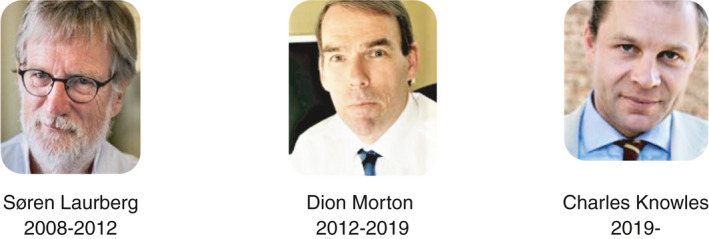
ESCP Research Committee Chairs 2008–2020.
Mike Parker had been Treasurer from the early days of the EACP and then the ESCP. He successfully attracted sufficient sponsorship to offset the financial burden of amalgamation fees and the expenditure of the Lisbon meeting. Even with a conference turnover beginning to approach €1 000 000, such was the growth in capital reserves (Fig. 15; Table 8) that the award of multiple travel fellowships in 2008 was possible for trainees and young surgeons to attend the Alpine Colorectal Meeting in Verbier, Switzerland. Other achievements at that time included linkage of French regional teaching centres to the Annual Meeting in Nantes, supported by Covidien (and more recently by Medtronic). Similar 2‐day placements became a regular feature at all subsequent Annual Meetings. Funding also became available to enable a US fellow to attend the Nantes meeting. A reciprocal Japanese Travelling Fellowship was established to allow European trainees to visit Japan and vice versa, and funds were made available for trainees to visit regional centres in the UK and the Prague meeting in 2009.
Anders Mellgren had been the Secretary from 2003 and played a vital role over the merger period, working effectively from Minnesota at the end of his term in 2009. He was followed by Ronan O’Connell (Fig. 19) who continued as Secretary until 2012 [2, 26].
The year‐end balance in 2008 was almost €250 000 after steady growth in membership (Fig. 17) and more corporate sponsorship. Such was the importance of the National Representatives in contributing to Council discussion that the ESCP Council decided to fund annual travel and hotel expenses to encourage their attendance at the winter meeting of Council in Vienna (c).
National economies in Eastern and Western Europe were out of balance after dissolution of the Soviet Union in 1991 and reduced registration and membership fees were offered to surgeons from Central and Eastern Europe (Table 4). By 2008 National Representatives expressed a preference for serial annual increases to achieve parity by 2010, in line with economic recovery. Lower fees were retained for non‐EU member countries (c).
Turbulence in the executive
At an executive meeting at Schiphol Airport in 2007, discontent over an accusation of financial mismanagement in the organization of the joint EACP/ ECCP Bologna meeting in 2005 was amicably resolved after the audited accounts were examined.
There was intense discussion on whether the administration should remain in Scotland or move to a more central position in Europe. Central and Eastern European members favoured moving to Austria. The Trustees (Directors) elected in 2005 were required to comply with Scottish company law, although not with Austrian law, in their responsibility to oversee ESCP finances. Jens Kirsch, the first Chair of the Trustees’ Committee (Fig. 26), arranged to draw up day‐to‐day working ‘Rules’ under Austrian law, using the Edinburgh template, and the ESCP was registered as a company in Austria in 2007.
Figure 26.

ESCP Trustees Committee Chairs 2006–2020.
Despite these difficulties within the Executive and Council, Lars Påhlman brought a stabilizing influence to east/west relations during his presidency in 2006/2007. Conversion of the pre‐existing EACP company shell into a new ESCP company in Edinburgh required few changes costing <€5000, without the need for the more expensive legal costs of winding up the company and transferring it elsewhere (b).
Despite its new Austrian status, the ESCP continued to function as a Scottish company. In contrast to Austrian taxation law there was no VAT on Integrity’s fees and no requirement to be VAT registered for conferences. Delegates’ registration fees were VAT exempt and therefore cheaper. European internet banking transactions were possible in the UK but not in Austria at the time, so setting up an Austrian bank account was deferred.
Financial stability was essential and took precedence over any national consideration. The compromise agreed unanimously at the meeting of Council at Heathrow Airport in 2008, which was quorate despite some members being absent, was to retain the Scottish ESCP company, its device (trademark) and Integrity’s administration for a further 3 years, renewable subsequently by mutual consent.
To satisfy ideological needs, at least one Council meeting would be held annually in Vienna with the Austrian company retained as a subsidiary, which was a ‘workable solution’ agreed by the Austrian lawyer. Not least, continuity was important for the Treasurer and incoming Secretary, who would otherwise have had great difficulty transferring to a completely new administration in Austria [26].
These factional differences, which threatened to undermine the ESCP’s very existence, came to a head again at the Executive and Council meetings in September 2008 in Nantes, when Andrew Shorthouse was President (b). Despite earlier agreement reached by Council in Heathrow a few months earlier in May, it was argued by some present that to retain the Scottish company and administration was unacceptable and the ESCP administration and funds should transfer forthwith to Vienna, on the grounds that the status quo in Edinburgh would undermine future relations within the Society. To dispense with the services of Lindsey Whitehouse and Integrity would have involved unnecessary expenditure merely to ‘reinvent the wheel’. To appoint an Austrian administrator, freelance or otherwise, was a much more expensive option because of the unfavourable VAT regulations and employment law implications. Although it had been agreed that the appointment of an ESCP administrator should be competitive on the open market, ongoing management in Scotland was of overriding importance as it was already cost‐effective and efficient. There had also been a previous EACP agreement in 2004 that the Company should be based in the same country as its administration.
Lawyers and accountants in Edinburgh, familiar with matters relating to the EACP and latterly the ESCP, were closely aligned to the secretariat. Continuity was logical and essential. Submission of financial records to Vienna, while maintaining conference arrangements in Edinburgh and the need to share the membership database, would have been administratively inefficient, cumbersome and excessively expensive. Failure to reach a timely and pragmatic resolution to the dispute threatened to be extremely damaging to the ESCP, as well as expensive in legal charges. Legal and accountancy advice during the merger negotiations had already cost the ESCP €36 000.
The Executive was by now prepared to accept a putative loss of support in Central and Eastern Europe in order to achieve a final resolution in favour of administrative continuity in Scotland [26].
The Chairman of the Trustees disagreed and resigned on principle at the AGM in Nantes. The Council was narrowly split in favour of Scotland and the Executive’s endorsement was formally accepted at the Prague AGM in 2009 (c).
Minor alterations to the Scottish Articles and Memorandum in 2010 brought them into line with the Austrian Statutes. The Austrian company was wound up and the ESCP was permanently transferred to Scotland (c).
Prague 2009
President Tomas Skřička (Czech Republic) www.escp.eu.com/images/pdf/final_program/ESCP‐Prague‐2009‐final‐programme.pdf
As the internal political dust settled in 2009, the meeting in Prague, with Tomas Skřička as President, was the first to be held in a Central European country, demonstrating that the ESCP had become an internationally accepted pan‐European organization. More than 900 delegates attended, making it one of the largest held in the speciality outside the USA (c) (Fig. 16; Table 8). Unanimous agreement was finally reached at the AGM on all aspects of membership, administration, legal and company status, allowing the ESCP to move on and leave factional politics behind (c). Adam Dziki and Tomas Skřička were instrumental in bridging the gap between pragmatism and national interest.
Some significant changes were made to the scientific programme, encouraged by the newly formed Education and Training Committee which began to widen its remit to improve the Annual Meeting for delegates. All symposia and keynote lectures became plenary, allowing a 34% increase in parallel free paper and oral poster sessions.
Chapter 4
The European Society of Coloproctology 2009–2019
Consolidation and expansion
Central to the ethos of the ESCP was an academic and financial commitment to education, initially conducted through the Annual Meeting and collaboration with other societies and academic institutions. Although a successful Annual Meeting was important for its scientific value, there was a major opportunity during the meeting to promote coloproctology as a multidisciplinary specialty.
Changes in the committee structure
When the ESCP held its first meeting in 2006, its committee structure and administration had evolved from the template developed by the EACP. In 2010, Council was refined. Its committee structure and membership and the changes occurring over time are shown in Tables 6 and 7. Terms of reference were introduced for the Scientific, Education and Training, Research, Website and Journal committees and the Trustees.
With unanimous approval at the 2009 Prague AGM, the 2006 Articles of Association and Memorandum (Rules) were updated to facilitate transfer of all company documentation and administrative responsibilities from Austria to Scotland (c). Further updates and amendments of the Rules were made as necessary year on year. There were concerns about communications and notifications by e‐newsletter that were in breach of the existing Rules in 2016. Further amendments in 2017 allowed future new resolutions to be passed by a show of hands without the need for a proposer and seconder (l). Revision was again required to accommodate a new working group, chaired by Carolynne Vaizey (Fig. 27), to address the significant challenges of global outreach, geographic balance and gender issues within the committee structure and the Annual Meeting (n, k).
Figure 27.
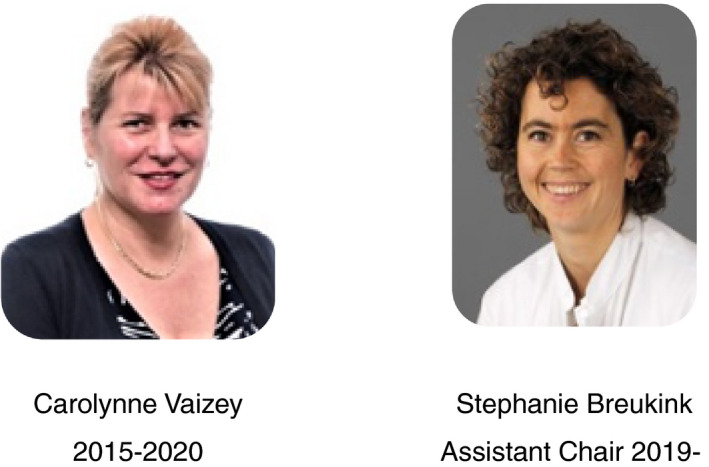
ESCP Guidelines Committee Chair 2015–2020.
Frankfurt replaced Vienna as the annual venue for winter Council meetings from 2011, to allow easier single‐day travel for National Representatives coming from all parts of Europe. This resulted in a saving of €4000 in accommodation and travel costs (e).
The Executive Committee, responsible for the day‐to‐day business, forwarded recommendations to Council for ratification at the AGM. From 2011, the President was retained on the Executive for a year after demitting office to add experience to the Committee. The chairs of the Website, Membership and External Affairs committees were added to the Executive as ex officio members in 2012 (e).
Committee structure was rationalized and expanded between 2014 and 2017, reflecting the increasing complexity of the organization and the challenges of governance. Guidelines and Nominations Committees, whose chairs each had voting rights on the Executive, were established in 2015 from ad hoc working groups (j). Shortly afterwards in 2016, the Nominations Committee was disbanded as the Executive took over the role of making recommendations for Honorary Membership, awarded from 2010 to those considered to have made an outstanding international contribution to coloproctology. Recipients up to 2019 (Fig. 28) were John Nicholls, Lars Påhlman, Cor Baeten, Freddy Penninckx, Hector Ortiz, Stanley Goldberg, Mike Parker, Steven Wexner, Koutarou Maeda, Werner Hohenberger, Angeleta Habr‐Gama, Adam Dziki, Søren Laurberg, Najib Haboubi, Giovanni Romano, Bill Heald, Heidi Nelson, Zoran Krivokapic, Ronan O’Connell and Yury Shelygin.
Figure 28.
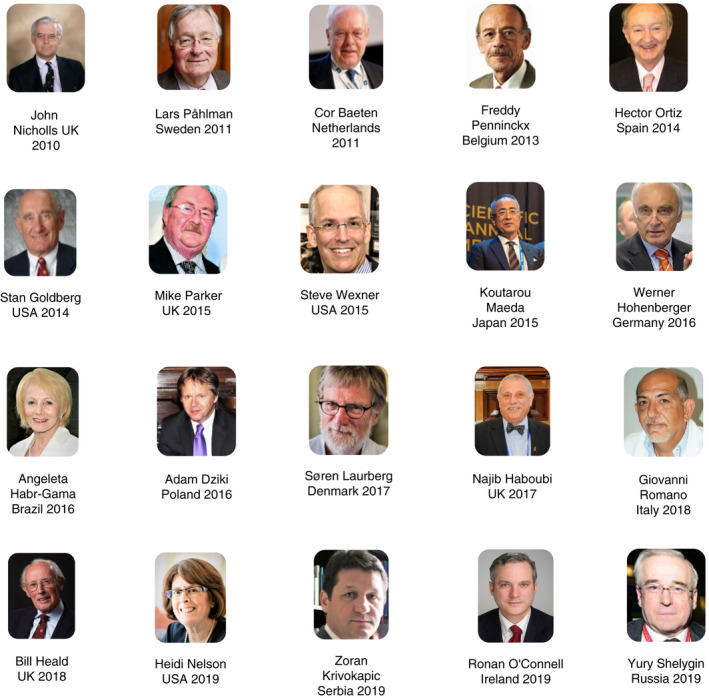
ESCP Honorary Members 2010–2019.
The External Relations and Website Committees combined to become the Communications Committee (Fig. 29) in 2015, chaired by Per Nilsson (j). A Regional Events Working Group (REWG), formed in 2015 (j), was formalized in 2016 in Milan and chaired by Paul‐Antoine Lehur (k). Its aims were to support educational events other than the annual meeting, such as masterclasses. Executive additions were the Chairs of Communications in 2016 and Young ESCP (Fig. 30) in 2017 (k, l) [22, 28]. The ESCP Committee structure, summarized in Fig. 13, had evolved rapidly by 2019 to reflect the expanding global activity of the Society in education, research and its numerous affiliations.
Figure 29.
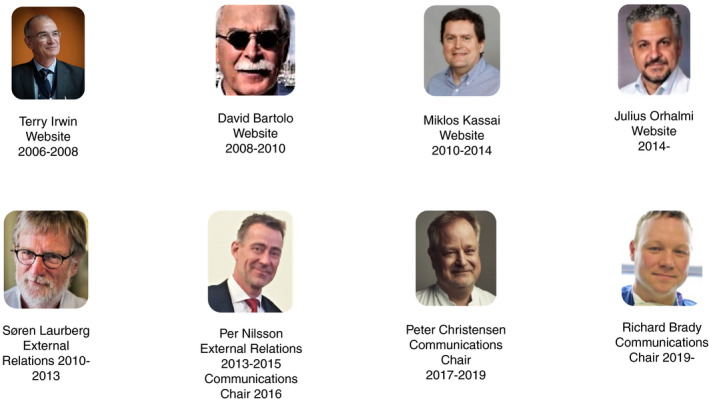
ESCP Communications Committee (combining Website, External Relations and Communications Committees in 2016) Chairs 2006–2020.
Figure 30.
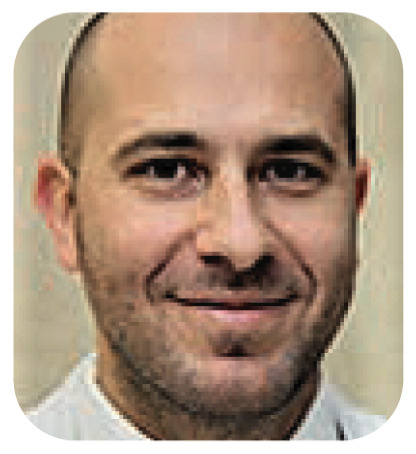
Young ESCP Matteo Frasson Committee Chair 2017–2020.
Infrastructure and administration
By 2011 annual administrative costs had risen to €92 250, reflecting the expansion of the organization and the increasing investment in education, research and the website. Integrity had remained loyal throughout and celebrated 20 years of successful collaboration with the EACP and ESCP in 2018. During this time Lindsey Whitehouse and her team had provided seamless first‐rate administrative support, with excellent organization of conferences while maintaining close relations with industry. Constant liaison between the Administration and the Executive allowed the Society to remain financially viable, secure and functional.
Increasing membership
Up to 2009, 50% of members had come from Northern and Western Europe but after this time there was encouraging growth from Eastern Europe and even from other continents (Fig. 17; Table 8). Poor growth in the Central region was a concern. The Netherlands and Belgium had the highest membership in proportion to the overall national number of coloproctologists, but many other countries, such as Germany, Poland, France, Turkey and Russia, were significantly under‐represented. The potential for further recruitment of members in Europe and outside was therefore huge. National Representatives were regarded as the catalyst for the recruitment of new members.
Stefan Post became Chair of the newly established Membership Committee (Fig. 23) in 2012 (g). Its main aim was to promote membership through improved organization of the National Representatives. The chair had voting rights on the Executive (Table 6) and was appointed for 3 years on merit rather than by regional rotation. Two members from each of the three regions formed the rest of this committee (e). At the AGM in Vienna in 2012 it was agreed that there should be a minimum of three members from any one country which then became eligible for national representation on Council (g). Although there was a steady growth in membership between 2010 and 2014 in the Netherlands, Sweden, Russia and the UK, it was static elsewhere. Nevertheless, the ESCP continued to gather momentum and by 2018 there had been a 98% increase in membership over the previous 4 years (Fig. 17), consistent with an almost exponential rise in delegate numbers attending the Annual Meeting in Nice in 2018 (Fig. 16) (m). The reasons were multifactorial and included not only the attraction of a beautiful city but also the sessions on high quality science, research, training and certification and website content, all made possible by prudent financial management and the efforts of the Communications Committee in raising awareness of the ESCP’s international profile. More consistent information was rapidly disseminated to members through e‐newsletters and a huge expansion of communication through social media. Membership rose again in 2019, with approximately 15% from outside Europe: 40% of countries globally now have at least one member (Fig. 17).
Corporate membership
Instrument and pharmaceutical companies advertise and promote their products, e.g. at the trade exhibitions, in return for their financial support of symposia or workshops held during the meetings and funding of fellowships. Over the years, excellent working relations have been established with many companies without compromising ethical standards.
By 2011 the ESCP had become fully compliant with guidelines issued by the European Confederation of Medical Suppliers Associations (Eucomed), acting on behalf of the medical device industry [29]. In 2011, one company resumed its financial support for the Annual Meeting in Copenhagen which it had previously withdrawn (e). This was conditional on meetings being held in a major city conference centre to avoid any accusation by US regulatory authorities of being complicit with ‘jollies’, for example, in ski or coastal resorts. The valid counter argument that such venues attracted larger numbers of delegates without compromising scientific quality did not prevail. To ease the Treasurer’s workload, the ESCP responded to the need for closer ties with industry by creating the Corporate Liaison Group in 2015, chaired by Paul‐Antoine Lehur (k).
Finance
Mike Parker, formally Treasurer of the EACP, took over the same role in the ESCP (Figs 14 and 15; Table 8). He was a financial wizard, serving both organizations continuously from 1999 until 2010. He quickly established a sound financial base, allowing the ESCP to expand. The 5‐year financial targets set on its formation were reached by the end of 2009, by which time the income from annual membership fees more than covered Integrity’s administrative costs. Mike Parker’s successors, Thomas Schiedeck, Paul‐Antoine Lehur, Filippo La Torre and latterly Miguel Pera, followed a similar financial framework, directing surplus income into capital reserves as a buffer against any unforeseen financial catastrophe, such as a cancelled meeting, as actually happened in 2016 (k) and again in Vilnius in 2020.
By 2012 capital reserves accrued from membership and conference registration fees as well as from industrial support allowed significant committee expansion between 2013 and 2016. Conference registration fees in Belgrade in 2013 (h) were reduced as an inducement for new membership and vindicated by a significant rise in conference income. The following year, free congress registration was offered to medical students (i, l).
From 2010 onwards, to comply with UK charity law, surplus funds were disbursed for clinical trials, travelling fellowships, workshops, communications (web and media activity) and guidelines. Investment in 2016 alone was €300 000 (d). Subscriptions to Colorectal Disease and the European Manual of Medicine: Coloproctology [30] were included in the membership fee from 2016, giving significant extra value to members (k). Risk‐adjusted investment of the remainder of the surplus (€400 000) was made into Luxembourg (ING – Lux) (k), leaving €700 000 in capital reserves to withstand any unforeseen financial disaster.
Because of political instability in Turkey, the Executive agreed, at 7 months’ notice for planning purposes, to cancel the planned Annual Meeting in Istanbul in 2016. Although it was possible to transfer the meeting to Milan, it came at a price. Year‐end capital reserves fell by €355 000 to €853 742 due to cancellation penalties of €91 100 (Table 8; Figs 14 and 15). There was also the loss of a major sponsor who was unable to support both a meeting outside its designated European region and to reinstate Milan into its budget that same year and a decision by the Turkish members not to renew their membership. However, a commitment already made to disburse and invest funds was never an existential threat (l).
Prudent financial management had been enshrined in the original Articles and Rules of the ESCP and was overseen by the Trustees (j, l). To avoid over‐spends from 2016 onwards, a new Finance Working Group was created to tighten fiscal control of committee and conference spending, with closer scrutiny and a more balanced approach to investment in major projects (m).
Ten years after the foundation of the ESCP, huge financial transactions had become a major management challenge for the Treasurer and Trustees. Committee investments and other charges in 2017 totalled €530 470, with a grant to the Research Committee of €111 001, mostly to fund the appointment of a new research manager. Other committees (Education and Training, Guidelines, Communications and Membership) were granted €99 240, €14 375, €86 091 and €11 162 respectively. Funds for masterclasses, affiliations and administration by Integrity totalled €183 920. It was fortunate that growth in expenditure continued to be covered by increased membership and industrial support.
Early in 2018 further disbursement of €58 000 for research, €58 500 for education and training and €28 250 for the app, website and social media projects left a temporary shortfall of €94 887, but fortunately this was more than compensated by projected income.
The expense of face‐to‐face committee meetings, costing €59 000 in 2016 and €63 000 in 2017, needed to be addressed. Each committee was required to reduce its non‐conference budget by 20% (l). Despite ongoing concerns about potentially unsustainable expenditure, income rose substantially from new membership, support from industry and a record 1882 delegates attending the meeting in Nice (m) (Figs 16 and 17; Table 8). After a financially difficult 3 years, careful budgeting continued in 2019 with revised speaker expenses and further efforts to generate funds with key sponsors and to stimulate membership growth (l).
The financial and strategic implications of COVID‐19 in 2020 after cancellation of the Annual Meeting in Vilnius were unknown at the time of writing.
Annual Meetings from 2010 to 2019
The Annual Meetings are listed in Table 5. The scientific content of all past meetings can be accessed on www.escp.eu.com/conference‐and‐events/past‐conferences in Appendix S1. Presidents’ reports are referenced separately.
Sorrento 2010
President Giovanni Romano (Italy) www.escp.eu.com/images/pdf/final_program/ESCP‐Sorrento‐2010‐final‐programme.pdf
Attendance at the 2010 Annual Meeting in Sorrento showed that recruitment of more Eastern and Central European members was a priority, as only 30% of delegates at the meeting came from outside the northwest part of Europe. Attracting trainees to attend meetings was clearly of prime importance, despite the recent reduction in membership fees and conference registration rates. The success of the meeting depended heavily on the financial support and generosity of industry and fortunately only one of the companies approached decided not to contribute.
Copenhagen 2011
President Freddy Penninckx (Belgium) www.escp.eu.com/images/pdf/final_program/ESCP‐Copenhagen‐2011‐final‐programme.pdf
The 2011 Annual Meeting was originally planned for Valencia, but a coinciding commercial exhibition in the city forced the ESCP to move to Copenhagen. Covidien generously supported an important educational initiative for trainees with the award of two major grants of €48 000, which funded eight pre‐conference minimally invasive surgery fellowships in Malmö and Copenhagen in addition to 3‐month residencies in specialist units hosted by ESCP members. Bursaries were awarded by Medtronic (€40 000) for 10 additional 3‐month fellowships, supplemented by a €70 000 contribution from the ESCP. By this time, the BK Medical sponsored pelvic floor ultrasound and core subject update pre‐meeting courses were well established (e) [31, 32]
Vienna 2012
President Zoran Krivokapic (Serbia) www.escp.eu.com/images/pdf/final_program/ESCP‐Vienna‐Final‐Programme.pdf
At the Annual Meeting in Vienna in 2012, the scientific programme was more compact, giving delegates the opportunity to return home before the weekend (g). The meeting was again preceded by the popular BK Medical sponsored pelvic floor ultrasound course led by Anders Mellgren. Symposia included ‘How to write a paper’ by the Editor‐in‐Chief and editorial staff of Colorectal Disease and there were excellent keynote lectures, including Ronan O’Connell’s ‘Thirty‐five years of ileoanal anastomosis’ and Klaus Matzel’s ‘SNS – time for critical appraisal’ [32].
Belgrade 2013
President Søren Laurberg (Denmark) www.escp.eu.com/images/conferences/2013‐Belgrade/documents/ESCP‐Belgrade‐2013‐final‐programme.pdf
In 2013, the Education Committee was restructured to provide educational support for trainees and specialists on the website and at the Annual Meeting. Feedback identified specific educational needs, leading to the development of appropriate training modules. The Annual Meeting was attended by over 1000 delegates. Zoran Krivokapic, who hosted the meeting, introduced courses on scientific paper writing, innovations to reduce anastomotic leakage and clinical trials updates, which were all in addition to the established pre‐meeting anorectal and pelvic ultrasound workshops.
Barcelona 2014
President Ronan O’Connell (Ireland) www.escp.eu.com/images/conferences/2014‐Barcelona/documents/escp‐barcelona‐final‐Programme.pdf
By 2014, with tremendous help from industry, 30 fellowships and 12 pre‐conference placements to specialist units had been awarded to senior trainees and specialists in their first 5 years of practice. Links were established with the Latin American, Chinese and Korean societies for reciprocal exchange of trainees. Covidien, Ethicon, Frankenman and Medtronic were all Diamond sponsors [33]. As a new educational resource for the Annual Meeting in Barcelona in 2014, the programme included CPD linked with requirements for the EBSQ examination. This supplemented a new web‐based educational package with access to pre‐recorded keynote lectures and symposia from previous Annual Meetings and the electronic text version of Springer’s European Manual of Coloproctology [30, 33].
2015 Dublin
President Yury Shelygin (Russia) www.escp.eu.com/images/conferences/2015‐Dublin/documents/ESCP_Dublin_final_programme.pdf
The 2015 Annual Meeting in Dublin featured the first pre‐congress laparoscopic skills course, hosted by the Royal College of Surgeons in Ireland, and a proctology skills course. For the first time, members who passed the EBSQ examination became ESCP Fellows and received complimentary ESCP membership for 1 year. Joint symposia were held with ESCP‐ECCO and ESCP‐EAES (European Association of Endoscopic Surgery), which continued annually thereafter. A pivotal event in ESCP history was the inaugural masterclass, organized in Moscow by Yury Shelygin during his presidential year [34] (Table 9).
Table 9.
Masterclasses.
| Venue | Date | Topic | Affiliation |
|---|---|---|---|
| Moscow (1st) | 2015 | IBD multidisciplinary team approach | ECCO |
| Katowice (2nd) | 2016 | Modern and advanced management of rectal cancer | Polish Club of Coloproctology |
| Almeria (3rd) | 2017 | Novel management of pelvic floor disorders | Asociación Española de Coloproctologıa |
| Budapest (4th) | 2017 | Improving quality of care in colorectal cancer | Hungarian Surgical Society (Coloproctology) |
| Stockholm (5th) | 2018 | Management of colon cancer | Swedish Colorectal Days |
| Rome (6th) | 2018 | Complex anal fistula | Societå Italiana di Coloproctologia (SICCR) |
| Antalya (7th) | 2019 | Re‐operative colorectal surgery | Turkish Colon and Rectal Surgery Congress |
| Cardiff (8th) | 2019 | Colorectal surgery – tomorrow’s world | Welsh Surgical Society |
| Amsterdam (9th) | 2020 | Rectal cancer surgery – the aftermath | Dutch Working Group for Coloproctology |
| Lisbon (10th) | 2020 | Complex decisions in coloproctology | Portuguese Society of Coloproctology |
The 9th and 10th Masterclasses were rescheduled to take place in June and January 2021 respectively due to the COVID pandemic.
Milan 2016
President Stefan Post (Germany) www.escp.eu.com/images/conferences/2016‐Milan/documents/ESCP‐Milan‐2016‐Final‐Programme.pdf
The Annual Meeting planned for Istanbul was cancelled at short notice due to political unrest, leaving only a short time to find an alternative venue. It was a difficult situation for Integrity who rose magnificently to the challenge. Suitable conference facilities were found in Milan.
Pre‐congress workshops [35] focused on fistula‐in‐ano and ultrasound. The educational sessions featured core subject updates, best publications, coloproctology around the globe, social media for coloproctologists, paper writing skills, the pros and cons of robotic surgery and interactive trainee sessions. Free papers were considered too important to continue being delivered in parallel sessions. Oral poster presentations were abolished, allowing a 74% increase in the number of free papers [22]. Arshad Malik was the first recipient of the Lars Påhlman medal, awarded to the best candidate taking the EBSQ examination (Fig. 31) (k).
Figure 31.

The Lars Påhlman Medal. The inaugural Medal was awarded to Arshad Malik in 2016 for the best performance in the 2015 EBSQ examination.
In 2016 the revised curriculum was aligned with the regularly updated Coloproctology, the European Manual of Medicine with free online access for ESCP members [30].
Berlin 2017
President Emmanuel Tiret (France) www.escp.eu.com/images/conferences/2017‐Berlin/Documents/ESCP‐Berlin‐2017‐Final‐Programme.pdf
Pre‐ and post‐congress ESCP Annual Meeting courses were expanded and targeted at technical skills development, decision‐making and clinical judgement, all with advanced hands‐on experience and excellent faculty support. Topics covered were transanal minimally invasive surgery (TAMIS), parastomal hernia prevention and repair, management of perianal fistula and haemorrhoids, and a post‐congress colorectal laparoscopic skills course (l) [29]. From 2017, the Fellowship programme consisted of four observerships, five 3‐month fellowships including one for non‐EU members, two 6‐month fellowships and a new colorectal robotic surgery 6‐month fellowship. There were three reciprocal travelling fellowships with international societies (ASCRS, the Korean Coloproctological Society and the Japanese Society of Coloproctology) (l) [28]. Evaluation of fellowship activity after 2017 facilitated matching the training needs of applicants to appropriate teaching centres.
Nice 2018
President Ethem Gecim (Turkey) www.escp.eu.com/images/conferences/2018‐Nice/documents/ESCP‐Nice‐2018‐Final‐Programme.pdf
As a full member of the European Cancer Organization, the first joint symposium of ESCP with the European Hereditary Tumour Group was held in Nice on the genetics of colorectal disease.
Collaboration between ESCP and S‐ECCO, the surgical branch of the ECCO initiated originally in 2008, resumed with joint symposia at their respective Annual Meetings from 2018 [28]. There was also growing industrial support notably from the ESCP’s Diamond sponsors Ethicon, Frankenman, Intuitive, Medtronic and Takeda.
Vienna 2019
President Per Nilsson (Sweden) www.escp.eu.com/images/conferences/2019‐Vienna/documents/ESCP‐Vienna‐2019‐Final‐Programme.pdf
There were joint sessions with the EAES, the ECCO and the European Tumour Hereditary Group. Hands‐on courses included TAMIS, operative techniques for the prevention and repair of parastomal hernia, anal intraepithelial neoplasia (AIN) and high‐resolution anoscopy (HRA) for colorectal surgeons, advances in fistula surgery, vacuum‐assisted closure, colorectal robotic surgery and the 11th Anorectal and Pelvic Floor Ultrasound course. Keynote lectures featured prehabilitation nutrition and optimization for major surgery, malignant polyp management and rectal carcinoma in the young. An interactive debate on diversion (or not) for pelvic anastomosis was instructive and entertaining (k).
Education and training www.escp.eu.com/education
Education and training lie at the core of the ESCP ethos, delivering and expanding high quality, contemporary education in training and practice for colorectal surgeons, trainees and allied health professionals. This is achieved through the programme of the Annual Meeting, internet‐based educational resources on the website, interactive educational content for the membership across Europe and the educational platform of the European School of Coloproctology [36].
Education and Training Committee
The Education and Training Committee was established in 2009, after the ESCP had become financially secure and its political differences had been resolved. It addressed the need to engage with UEMS for training unit recognition and accreditation, align with the requirements for the EBSQ Coloproctology diploma, expand the travelling fellowship network, and support an increasing portfolio of educational resources other than the Annual Meeting.
Successive elected chairs continued to refine the committee structure to address the consequences of ESCP expansion and its greater role in training, accreditation, certification and links with other organizations. The chair of this important committee was successively occupied by Lars Påhlman, Klaus Matzel and Dieter Hahnloser (Fig. 24; Table 6). In 2013, the Education Committee was restructured specifically to address Continuing Professional Development (CPD) and to align its activity and content with the EBSQ Coloproctology diploma requirements [33].
Annual Meeting
The Annual Meeting was the only educational facility on offer in the early years and was organized by the Programme Committee (Fig. 20), initially chaired by John Nicholls. Since then, the committee has been chaired successively by Emmanuel Tiret, Donato Altomare, Anna Martling and currently Des Winter.
The organization of the programme for the Annual Meeting remains its main responsibility. The challenges are to identify current trends and ‘hot’ topics, organize keynote lectures and achieve a balanced programme through an equitable arrangement of free papers and poster presentations. The format of the meeting has been continually refined over the years, with significant early changes towards plenary sessions for all symposia and keynote lectures, allowing more opportunity for trainees to present their clinical and academic work in parallel sessions. Abolition of oral poster presentations led to a significant increase in the number of free papers presented [22]. The committee from the outset engaged high‐profile, internationally renowned keynote speakers to enhance the quality of the meetings. The consistent rise in delegate and membership numbers over the last decade (Figs 16 and 17) is a testament to the very high quality of the academic programme structure.
Educational sessions are targeted towards technical skills, decision‐making and clinical judgement. They include interactive workshops, ultrasound seminars, expert video sessions, authors’ workshops and expert round table sessions [22]. Free registration is now available annually for 50 medical undergraduates as a potential steer to an early career choice (l).
The Programme Committee is the most geographically and gender‐balanced of all the committees. Involvement of more women and more members from Eastern and Southern Europe is an ongoing trend. The scientific programmes from 2006 (Appendix S1) can also be found at www.escp.eu.com/conference‐and‐events/past‐conferences [4, 25].
Pre‐congress workshops https://www.escp.eu.com/education
Expansion of pre‐ and post‐congress Annual Meeting courses has led to valuable hands‐on technical experience with comprehensive faculty support [22, 34, 35] (l). Courses have covered a wide range of controversial topics such as perianal fistula, haemorrhoidal disease, parastomal hernia, HRA for identification of AIN, vacuum‐assisted management of the open abdomen, anastomotic leakage, abdominal wall reconstruction, TAMIS, advances in fistula surgery and robotic surgery.
European School of Coloproctology (ESC/ESCP) www.escp.eu.com/education/european‐school‐of‐coloproctology
The ESC/ESCP is chaired by Klaus Matzel and offers educational opportunities to colorectal surgeons at different stages of their career supported by educational grants from industry.
A comprehensive 2‐day laparoscopic complete mesocolic excision programme was launched in 2018 in Hamburg to instruct participants in the use of the technique for colon cancer. Workshops, hands‐on training with cadaveric dissection by a standardized technique and proctored live operating are followed by close mentorship of participants’ early cases in their own hospitals.
A similar training curriculum for robotic surgery was launched in 2019 [36, 37] (n). In 2018 a workshop on ileoanal pouch and Kock ileostomy was introduced at the Johnson and Johnson Institute in Hamburg and was repeated in 2019.
Berlin Days was a new initiative, due to be launched in 2019, offering hands‐on experience and a variety of courses spread over 2 days. The first of these was to feature parastomal hernia, AIN/HRA, anal fistula, TAMIS and preparation for the EBSQ examination (n). Unfortunately low registrations resulted in cancellation of the event.
Union Européenne des Médecins Specialistes (UEMS)
The content of the ESCP scientific programme was linked to the syllabus and educational content of the EBSQ examination. This was made available on the ESCP website, including access to the recordings of previous keynote lectures and symposia [33] and the European Manual of Medicine: Coloproctology from 2017 [30].
The EBSQ Coloproctology examination, introduced in 1998 [12], was hosted exclusively by the ESCP from 2006 onwards [2, 14]. Initially it was held during the Annual Meeting but, owing to demand, in recent years it had taken place at other national meetings. By 2020 there were more than 500 diplomates. In a move towards mandatory acceptance by the European Accreditation Council of the UEMS (UEMS‐EACCME) the entire ESCP Annual Meeting was accredited in 2019 by the UEMS for Professional Development Points [22, 28]. Topics important for candidates preparing for the EBSQ are now colour‐highlighted (‘blue‐streamed’) in the programme. Close links with the UEMS are maintained by a UEMS Executive Committee representative who is also a voting member on the ESCP Executive (Fig. 32).
Figure 32.

UEMS Executive Committee Representatives 2006–2020.
Fellowships
From 2010 considerable reserves, surplus to essential expenditure, have been disbursed annually for travelling fellowships, supplementing generous support from industry [29, 38]. Important educational initiatives from 2011 included the funding of fellowships in minimally invasive surgery, residencies attached to specialist units hosted by ESCP members in the locality of the Annual Meeting and 3‐month fellowships across the world. The first ESCP pre‐congress laparoscopic skills course was held in 2015. A colorectal robotic surgery fellowship was introduced in 2017, supported by a grant from Intuitive Surgical, and is currently hosted in eight centres in the Netherlands, Italy, Spain and the UK [34].
The ESCP now awards one 6‐month robotic surgery fellowship, two 3‐monthly fellowships annually, 20 2‐week ‘observerships’, 10 pre‐congress placements, and reciprocal travelling fellowships with the American, Japanese and Korean colorectal societies [38, 39] (n).
Resource library
The online resource library on the ESCP website contains a comprehensive overview of all Education Committee activity and is constantly updated and arranged into topics and modules. The second edition of the electronic version of the European Manual of Medicine [30] is available at no extra charge to ESCP members and is linked to the content of the Annual Meeting [33]. Additionally, it forms the basis of the EBSQ examination, so is a vitally important resource. Most presentations and video material from the Annual Meeting are available to members on the website. The ESCP joined the ASCRS from 2019, allowing ESCP members to access the excellent ASCRS resource library. It is also working jointly with ASCRS to develop the Colorectal Educational Systems Template (CREST®). This is a unique collaboration between two major colorectal societies. By sharing educational resources, it will become a premier and globally accessible educational facility for colorectal surgery (n).
Regional Events Working Group (REWG)
The inaugural masterclass on multidisciplinary aspects of IBD was organized by Yury Shelygin during his presidential year (Table 9) [34]. It was held in Moscow in April 2015 in collaboration with the ECCO and the Russian Coloproctology Association. There were 1380 delegates from 28 countries attending this landmark event for pan‐European coloproctology. There was simultaneous translation in Russian and English [1, 40].
Following initial success, a new REWG, chaired by Paul‐Antoine Lehur, was established in 2016 to support educational events in Europe other than the Annual Meeting, thereby projecting the ESCP brand internationally [22]. The REWG masterclasses were designed to discuss single topics in depth [29], similar to the strategy initiated in 1999 by the EACP [41]. Evaluation after 2017 facilitated matching applicants’ training needs to an appropriate teaching centre.
Masterclasses were by now recognized as an important educational component of ESCP activity. They continued twice yearly in different European centres [40] (n). The REWG was examining opportunities to deliver ‘global reach’ events outside Europe [39], ideally in conjunction with national society meetings with scientific content under REWG control. Financial aspects and meeting organization would have remained the responsibility of the host. Applications for 2020 from Egypt, South Africa and China were under consideration prior to the COVID‐19 pandemic (n).
Industrial support
In addition to the important contribution to many different activities of the ESCP made by industry, its financing of speakers, pre‐meeting workshops, fellowships and core‐subject updates has been vital. Much of this has come from Diamond sponsors such as Ethicon, Frankenman, Intuitive, Medtronic and Takeda, and Sapphire sponsors including B. Braun and THD [38].
Research
The Research Committee
The Research Committee (Fig. 25) was established under the chairmanship of Søren Laurberg in 2009 when the first research symposium at the Annual Meeting on Trials Protocols was held in Prague. Its remit was to encourage international collaboration in clinical trials, to enhance the academic component of the Annual Meeting and to provide procedural guidance on clinical trials to ensure their quality (c). This strategy proved to be immensely popular and contributed significantly to an increasing interest in trials and other forms of research collaboration by the membership.
By 2009 accumulated capital reserves (Fig. 15, Table 8) were sufficient to allow investment in trials, basic science research and independent external protocol review. The Research Committee was able to offer advice to the membership on the procedural aspects of clinical trials.
Dion Morton succeeded Søren Laurberg in 2012 and introduced important initiatives to identify new areas of research, establish inter‐society IBD research networks, standardized pathways for collaboration with industry, an early phase trial application process, online case reports and database systems for international cohort studies [42].
Clinical trials, cohort studies and snapshot audits
European Union funds created opportunities for establishing clinical trials networks. A clinical trials forum was introduced at the Annual Meeting in 2014. ESCP members were invited to present trial proposals for publication in Colorectal Disease [33]. Comprehensive clinical trials information became available on the redeveloped website. The ESCP’s ambition to become a recognized portal for the organization and conduct of European trials was by now becoming a reality. In 2014, an International Trials Map [43] was launched on the website by Dion Morton, with hyperlink access to abstracts, protocols, contacts and recruitment status, in order to maximize participation by the membership and other groups. Funding streams were dependent on high quality evidence. Collaborative clinical multidisciplinary international research began to flow [42, 44]. The French GRECCAR trials were registered and there was collaboration between Holland, the UK and the Scandinavian countries, including the RAPIDO trial (Holland and Sweden), STAR TREC (Holland, UK, Denmark), COLOFOL (Denmark and Sweden), the FOXTROT trial (UK, Denmark and Sweden) and several Nordic trials including ALASCA.
ESCP funds were allocated to the Research Committee to appoint Daniel Mekic, University of Birmingham, as Research Manager [22]. Further ESCP funding pioneered a series of international prospective cohort studies employing unique methodology to provide an unprecedented insight into current colorectal practice [45, 46].
Multicentre snapshot audits, driven by Dion Morton, have been the most successful of the Research Committee’s initiatives. They have generated large datasets on surgical interventions and outcome at a fraction of the cost and time required for a randomized controlled trial, which itself may also be biased.
Cohort studies [45] have more power to bring together surgeons internationally to collaborate within an active research network. The ESCP adopted a strategy of promoting short duration, high volume prospective snapshot audits, which reached almost 50 countries and recruited over 10 000 patients. An aggregate of 1448 clinicians as collaborators in these studies is a testament to this achievement and is quite remarkable, presenting a level of diversity rarely seen in the scientific literature. Corporate authorship of the snapshot audit publications undoubtedly encouraged recruitment and ESCP membership. Audits of right hemicolectomy (2015), stoma closure (2016) and left colon, sigmoid and rectal resection (2017) were published together with an executive summary [46, 47]. The 2019 snapshot audits recently closed data recruiting on acute severe ulcerative colitis (MASC) [48]. Snapshot audits are popular, productive and efficient, raising important clinical questions which will inevitably lead to more long‐term international randomized trials. Young ESCP is making an important contribution to these studies [49].
Encouraged by the snapshot audits, the Research Committee is currently developing two major international prospective longitudinal studies on robotic colorectal surgery (RESET and MIRCAST) [50] and parastomal hernia repair (PROPHER) [51] with patient‐reported follow‐up to determine the functional outcome for colorectal interventions with uncertain clinical effectiveness.
An important international cluster randomized controlled sequence study (EAGLE), launched by the ESCP in 2019, is a quality improvement study aiming to reduce anastomotic leakage after ileocolic anastomosis. Almost 5000 patients will be recruited from 340 hospitals in over 50 countries [52] [Correction added on 16 October 2020, after first online publication: The preceding statement has been corrected in this version]. Recent collaboration between the Education and Research Committees on the anastomosis project combines education and research to improve patient care (n). Other new trials were announced in 2019. These studies are creating an important large network in Europe and beyond [53].
The ESCP is now the foremost surgical society in the world facilitating clinical research. It has led on trial design and by channelling funding it has achieved an impressive global reach. In 2019 Charles Knowles (UK) took over the Chair of the Research Committee from Dion Morton who continued on the committee as Global Research Lead [25]www.escp.eu.com/research).
Communication and collaborations
ESCP committees
The ESCP has engaged increasingly with other organizations. External Relations and Website Committees were formally merged into a Communications Committee in 2016 under Per Nilsson as chair (Fig. 29; Table 7). He quickly set about raising the ESCP’s public image, evolving a long‐term strategy to protect its identity, emphasize patient focus and engage in the political arena [32].
In 2010, reciprocal relations were established with the ASCRS with a commitment to run respective symposia at ASCRS and ESCP meetings. The winners of the six best ESCP and the best ASCRS papers presented at each other’s Annual Meeting were granted reduced registration rates for the ESCP meeting and vice versa (e).
In partnership with the ACPGBI, the ESCP had its own symposium during the Birmingham UK Tripartite Meeting in 2014. Registration fees for the ESCP meeting later in 2014 in Barcelona were discounted for those at the Birmingham meeting as an inducement to attend both. The Birmingham meeting unexpectedly produced shared profit of €50 000. The Lars Påhlman lecture became a permanent feature of the Tripartite programme and was first delivered at the meeting in Seattle in 2017.
Links with ASCRS, ACPGBI and the Colorectal Surgery Society of Australia and New Zealand led to collaboration from 2016 in the evaluation and implementation of new technology (k). The results were presented at the 2017 Tripartite Meeting in Seattle and the ESCP meeting in Berlin in the same year (l).
The most significant development was agreement that the ESCP should enter the Tripartite Meeting as an equal partner in New Zealand, originally scheduled for 2020 but deferred to February 2022 due to the COVID‐19 pandemic. The following meeting will be held in Continental Europe and will include an ESCP lecture at each meeting thereafter [28].
The ESCP collaborated with the ECCO in 2018 to produce joint IBD management guidelines [54]. It also developed partnerships with the European Society of Gastroenterology and Abdominal Radiology (ESGAR) [22, 28] and the European Society of Surgical Oncology [31, 32, 33]. Imaging workshops were held jointly with ESGAR in 2014 and 2018 in Amsterdam. Relations with ECCO continued to grow with symposia at the ESCP Annual Meeting. The ESCP became a full member the European Cancer Organization in 2016 [22].
Collaboration at every level with the UEGF was important for standardization of training in coloproctology throughout Europe (c). To this end, in 2010, the ESCP established representation on the UEGF General Assembly and on its more important committees [28]. ESCP membership of the UEGF and participation during UEGF week was rewarded by an annual income of €25 000 (c). More importantly, through its permanent representation in the UEGF, it gained a channel of communication to the European Union in Brussels.
The ESCP, EAES, European Digestive Surgery and the European Federation International Society for Digestive Surgery form the surgical block of United European Gastroenterology (UEG), known as the European Society for Surgery of the Alimentary Tract (ESSAT). These organizations featured collectively as part of ESSAT during Annual UEG week from 2017 onwards [22, 28].
Since its formation in 2015 and formalization in 2016, the Communications Committee (Fig. 19), or ‘Comm Comm’, has been led by Per Nilsson, Peter Christensen and Richard Brady. It has underpinned the ESCP’s influence and public profile by engaging with new audiences and partnerships such as Grayling, a communications and international public relations company, government and public and patient networks. It has achieved this by posting conference and committee developments on the ESCP website, by newsletter and by its persistent presence on social media as part of the ESCP’s overall global growth strategy (n).
Website, the app and social media
The original website established by Terry Irwin (Fig. 29) was important in the development of relations and communication with other organizations. The Chair of the Website Committee became a voting member on the Executive in 2012. Miklos Kassai replaced David Bartolo in 2010. His focus was to create a single coloproctology information hub for Europe, with lectures, sessions with experts, guidelines and links to national organizations.
A major upgrade of the website was undertaken between 2010 and 2012 costing €40 920. Improvements in system navigation and the addition of links to other organizations were designed to attract more non‐surgical members. IBD and pelvic floor fora were established. The radical redesign of the website was launched at the Belgrade meeting in 2013 after technical difficulties with the previous company had been resolved (h). Julius Orhalmi (Fig. 29) was elected Chair of the Website Committee in 2014, demitting in 2020. Further but essential development of the website in 2015 increased expenditure by 60%. Budget management came under scrutiny by the Treasurer and Trustees.
Richard Brady, the current Communications Chair, has considerable expertise with social media and an in‐depth knowledge of its strategic use (n). A new website company was engaged to support the growing wealth of educational material following a competitive tendering process. The new website www.escp.eu.com/ included free member access to presentations, keynote lectures and video material from annual meetings, sessions with experts for member interaction, a resource library, educational links, and online access to Colorectal Disease. The online European Manual of Medicine: Coloproctology [30] became available in a second edition in 2017.
The development of the Society’s ESCP app, listed on both Apple and Google app stores, reduced expenditure by supporting congress content online on a single app, and provided an easy all‐year‐round access point for members and a smooth platform to host annual congress content.
The ESCP resource library
The ASCRS resource library became available to members in 2019. By 2016, the ESCP held more than €800 000 in capital reserves with additional investment funds of almost €500 000. The ESCP invested heavily to provide an expanding portfolio of online educational and research material on its own website and with a presence on Twitter, LinkedIn and Instagram and the formation of a social media subcommittee.
Grayling was appointed in 2016 and supervised by the Communications Committee. Each year, Grayling’s realization of key performance indicator targets was of paramount importance when setting the following year’s budget (Table 10). An increased volume of videos followed, and the company became heavily involved in the monthly topic project, now led by Young ESCP [49]. Conference video channels on YouTube were set up and are hugely popular and successful. The Twitter account was established in 2016. An explosion of Twitter engagement at 39 000 (September 2019) and a 510% increase in 2018 alone demonstrated the immense power of social media (n).
Table 10.
ESCP key performance indicators (Grayling).
| Social media activity | Target | Achievements 2018 and 2019 |
|---|---|---|
| ESCP app downloads | 2950 | 3782 |
| Website visitors | 287 900 | 174 477 |
| Website page views | 1 520 000 | 924 389 |
| Twitter engagement | 136 500 | 74 924 |
| Twitter followers | 9500 | 3782 |
The ESCP app, launched in 2017, provided easy access to the whole website from hand‐held devices and for online and social media access [22]. Future projects are to address ESCP gender balance, global ESCP and further engagement with colorectal surgeons from Southern and Eastern Europe. Communication in the Eastern region has been particularly successful through a dedicated WhatsApp group (n). Key performance indicators clearly demonstrated the success of the social media collaboration with Grayling within a very short time (Table 10 ) (n).
Guidelines
The Guidelines Committee was established in 2015 and remains chaired by Carolynne Vaizey with Stephanie Breukink recently appointed as Assistant Chair (Fig. 27). The Committee produces guidelines based on the best available evidence using internationally recognized quality criteria. A detailed account of guidelines developed by the ESCP can be found on the ESCP website www.escp.eu.com/guidelines [55].
In 2019 those already published or awaiting publication included the following:
S‐ECCO–ESCP consensus on the surgical management of Crohn's disease [54]
Consensus and controversies regarding follow‐up after treatment with curative intent of non‐metastatic colorectal cancer: a synopsis of guidelines used in countries represented in ESCP [56]
Intestinal failure guidelines for surgical management in adults [57]
Guidelines on sacral nerve stimulation for faecal incontinence and constipation: a European consensus statement [58].
Guidelines for the treatment of haemorrhoidal disease are accessible on the ESCP website [59] and have been submitted to Colorectal Disease for publication (n).
Projects for the future include gene and gender guidelines for Lynch syndrome (GGGLS) in collaboration with the European Hereditary Tumour Group, follow‐up after primary colorectal cancer, social media guidance (as a resource in colorectal surgery, relationships between professionals, privacy, patient information protection, confidentiality), perianal fistula, use of a core outcome set (COS) in the treatment of haemorrhoidal disease, mesh in the pelvis, faecal incontinence, transanal total mesorectal excision (TaTME) and diverticulitis [55] (n).
Colorectal Disease
The ESCP Journal Representative (Fig. 33) has maintained close contact with the Editor and Publisher, John Wiley, of Colorectal Disease. The Editors‐in‐Chief (Fig. 34) past and present include John Nicholls (1999–2014), Neil Mortensen (2015–2019) and Neil Smart appointed in 2019. Colorectal Disease obtained an impact factor of 2.059 in 2008 which had risen to 2.997 in 2019. Keynote lectures at ESCP Annual Meetings, supported by Colorectal Disease and the British Journal of Surgery, are regular features [33]. Co‐ownership of Colorectal Disease with the ACPGBI was considered by the Council of the ESCP in 2011 but a decision was deferred. More recently interest in a partnership model for shared ownership has resumed, but the ACPGBI does not propose to relinquish ownership as the journal remains profitable. Colorectal Disease moved to become online only in 2019 [60] (n).
Figure 33.

Journal Representatives on the Council 2006–2020.
Figure 34.
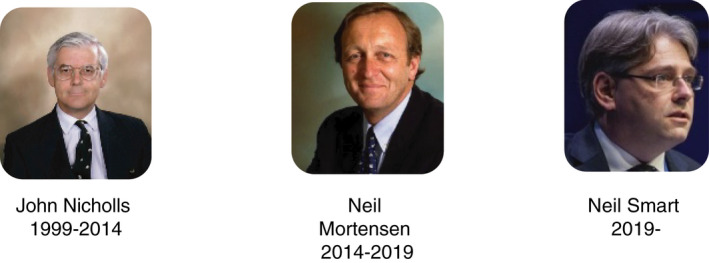
Editors‐in‐Chief of Colorectal Disease 1999–2020.
Trustees
ESCP business and finance are overseen by the Trustees. In 2013 a workshop in Dublin on strategic planning, convened by Werner Hohenberger, identified the need for a risk assessment subcommittee to manage potential long‐term financial and governance risks as the ESCP continued to expand. Its remit was to inform Council on contingency planning. One example was the development of a web‐based platform for the continuing educational and training needs of the membership, to satisfy CPD (j).
A rolling system of changes in the Trustee body was agreed at the 2009 AGM (c) to achieve regional balance and better continuity, with effect from 2012 (g). Further involvement in the ESCP by Russia was welcomed when Sergey Achkasov (Fig. 26) was elected as Chair of the Board of Trustees in 2012.
The Trustees had been addressing the ESCP’s financial position and were considering the transfer of assets held by ING‐Lux to an alternative investment fund (n). An advisory body, the Financial Working Group (FWG), initiated, organized and chaired by Gabriela Möslein, was formed because of concerns about the deteriorating financial position in 2016/2017 resulting from increased committee spending (e.g. committee meetings, research manager and Grayling appointments, communications). Supported by advice from Mike Parker, who had joined the FWG in 2018 and handled investments on behalf of the Treasurer and Trustees from the time the ING‐Lux account was established, expenditure by most of the committees was cut to restore the accounts to reasonable health. In 2019 ING made the decision to withdraw from its role as fund manager owing to uncertainties regarding the Society’s position in Europe and the impending Brexit decisions. Mike Parker and the Treasurer, after annual reviews with ING, recommended that the holding be sold and deposited in the bank. This proved to be a prescient decision as the stock market fell dramatically when the coronavirus crisis unfolded in early 2020. The Executive wisely agreed to retain the FWG in January 2020 ahead of the COVID‐19 crisis. There will be many critical financial decisions to be made in future strategic planning.
Young ESCP
In recognition of the importance of trainees to the ESCP, Young ESCP [49] was formed in 2016. The emphasis was on education and social integration into the ESCP. Its first chair was Matteo Frasson (Fig. 30) who at the time was the Young ESCP representative on the Executive. The only criterion for membership was as a member of the ESCP aged under 40 years. E‐mail lists, the ESCP app, social media and website contacts were established to facilitate communication amongst its members [22].
Each ESCP committee has appointed two or three young ESCP members to assist with the communication and promotion of committee content and activity, channelled through Grayling. Involvement of Young ESCP has significantly escalated @ESCP tweets and @YouESCP on social media (n).
There has been an extraordinary development in ESCP collaborative research projects carried out by the younger members over the last 5 years [49]. This has resulted in an international movement of young trained and trainee colorectal surgeons prepared to conduct multicentre clinical research on a vast scale. Young ESCP has thereby shown itself to be a major research force, competent to conduct clinical trials on relevant topics within a short period. It has grown in stature, collaborating in research, publishing its own articles and hosting sessions at the Annual Meeting to enable younger surgeons to be heard.
COVID−19
The consequences for the ESCP
On the 13 March 2020 the World Health Organization declared that Europe had become the epicentre of the pandemic, with a rapid and exponential rise in cases across the continent, doubling on average every 3–4 days (Fig. 35) [61].
Figure 35.
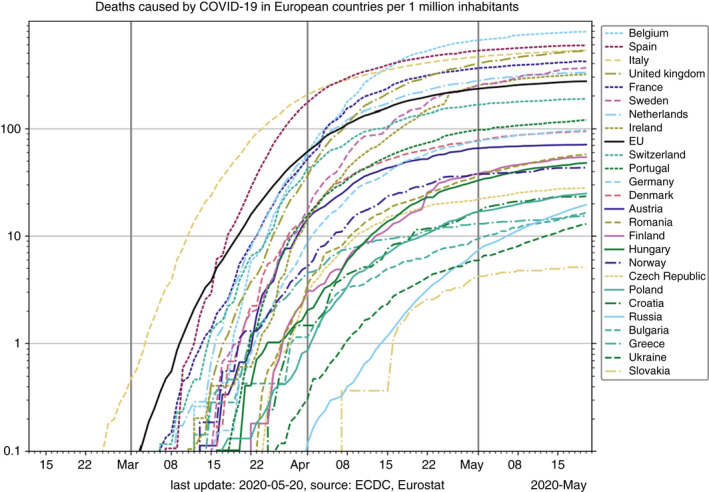
COVID‐19 March–May 2020. Cumulative number of deaths per million inhabitants for a selection of European countries over time [72].
By 18 March 2020, more than 250 million people were in lockdown across Europe. These rapidly changing events required an immediate and flexible response by the ESCP, Integrity and not least colorectal surgery throughout the continent. Two weeks later on 1 April 2020 the ESCP website announced cancellation of its September 2020 Scientific and Annual Meeting in Vilnius.
COVID‐19 was immediately a serious potential existential threat to the ESCP, with conference centre cancellation penalties in Vilnius and administrative costs of its organization and preparation. Loss of sponsorship revenue would have significant implications for future research, education and development of the website. The extent of these losses and success or otherwise of related insurance claims are currently unknown. Although the fundamental principle of setting aside capital funds sufficient to sustain cancellation of an Annual Meeting had been observed by successive ESCP Treasurers and Trustees, cancellation of Vilnius followed closely on the heels of Istanbul in 2016. Research, education and website budgets may need to be tightened until such time that capital funds have recovered.
Surgical education has rapidly evolved into a virtual electronic process. Grand rounds, morbidity and mortality conferences, journal clubs, tumour boards and other conferences have converted to online media with webinars, video‐conferencing and shared online educational resources [62].
Prospects for the Annual Scientific Meeting in Barcelona in 2021 remain uncertain and will depend upon lifting of restrictions and the return of confidence in air travel, accommodation, mass gatherings, sponsorship and the control of any recurrent spikes of infection. The value of social contact and exchange of ideas at the Annual Meeting cannot be underestimated. It remains to be seen when and if large unrestricted scientific meetings of this type will be held again in major European international conference centres in the near term or even beyond. Loss of the Annual Meeting in 2020 and uncertainty beyond meant survival and progression by innovation and adaptation [63].
The ESCP plan for the Annual Meeting in Vilnius 2020
At the height of the COVID crisis, the ESCP Executive was monitoring the developing situation very closely, knowing that travel restrictions were likely to continue and that the immediate focus for all members would be patient care and protection when health services everywhere were under intense pressure and sometimes overwhelmed.
From the outset of the crisis, online platforms became indispensable for communication, education, guidelines and dissemination of quality research. The ESCP Guideline Committee, led by its Assistant Chair Stephanie Breukink (Fig. 28), has been collaborating with the EAES and the Society of American Gastrointestinal and Endoscopic Surgeons to endorse, adopt and update their surgical response to COVID‐19 with recommendations posted in April 2020 on the ESCP COVID‐19 webpage. The website was being updated daily with surgical topics related to the pandemic, e.g. guidelines on open vs laparoscopic procedures, colonoscopy, personal protective equipment, treatment algorithms for common surgical conditions such as appendicitis, conservative surgery in the absence of diffuse peritonitis, guidance on rationing of services and for non‐urgent face‐to‐face meetings with patients and colleagues. Members could interact via @escp_tweets using the #COVID19ESCP hashtag [64].
The recent explosive development of social media has provided a rich source of collaboration, education, guidance and rapid dissemination of news and information (#ESCP2020, @YouESCP, @escp.tweets, #COVID19ESCP, @UemsSurgery, @UEMSEurope, and in collaboration with affiliated societies, e.g. @EAUS_eu#COVID19 Webinar).
At the time of writing, the topics and masterclasses included in the cancelled Vilnius programme were being developed into a virtual resource. Richard Brady, Communications Committee Chair, was spearheading the development of ESCP social media in response to the COVID‐19 crisis and, as a measure of its importance to the membership, fast‐tracked the formation of a new social media subcommittee, operating under the oversight of the Communications Committee. Its remit was to continue developing social media, rapidly responding to news, and optimizing and tailoring the content for the next generation of colorectal surgeons on Twitter and the recently established Instagram account (ESCP.insta).
Online global educational resources, already shared with affiliated organizations such as ASCRS (CREST), AIS Channel, PanSurg and the ESCP’s own extensive resource library, were becoming increasingly important. For instance the AIS Channel, pioneered by Antonio Lacy, with more than 30 000 IP addresses of participants in almost 150 countries, had plans to host key international colorectal surgery conferences online globally during the COVID‐19 lockdown [65]. PanSurg offered educational webinars via live conferencing aimed at delivery of safe, effective surgery and research on the impact of COVID‐19 on surgical intervention [66]. Sharing international experience and understanding the implications and risk of a second wave will be important during the recovery phase of COVID‐19.
Crisis drives innovation and there was an urgent need to optimize both patient care and surgical education during the pandemic while reducing the cost of delivery. Proximie, a technology platform, had already been collaborating with the ESCP to facilitate colorectal education and share expertise remotely in a live setting for TaTME, robotic and laparoscopic complete mesocolic excision. Remote interaction before, during and after surgery saves time and cost of travel for operative training which hitherto had been held face‐to‐face in Johnson and Johnson's facility in Hamburg but has been used remotely and successfully during the pandemic with travel restriction and the need for social distancing [67].
As COVID‐19 struck at the end of 2019, there was no evidence base for the surgical management of infected patients. By early April 2020, the ESCP had already established a partnership with CovidSurg [68] for international collection of data to inform clinical practice and establish its impact on the surgical team and elective surgery cancellations [69, 70, 71]. The ESCP is an important strategic partner for CovidSurg, with its unique experience of conducting large scale global cohort studies that have had such a major influence on clinical practice.
The future of the ESCP; view from the Secretary General, Gabriela Möslein, July 2020
In a statement of her vision for the future Professor Möslein has written:
Since 2005, the ESCP has evolved into one of the largest societies in the field of coloproctology, and it has done so at an astonishing pace. This success has followed the dedication of a creative and passionate team of clinicians, researchers and administrative staff who quickly embraced the society’s values of inclusivity, diversity, global engagement and excellence in education and research. Their dedication, in attracting and mentoring young talent, developing systematic evidence‐based guidelines, scientifically evaluating new health technologies and facilitating education and implementation, has led to a track record of scientific publications and changes to practice that are rightly the envy of other societies. At the time of the COVID pandemic, the society had a portfolio of research and educational activities that included a ground‐breaking global randomized controlled trial and a burgeoning timetable of ESCP School of Coloproctology events.
The pandemic has undoubtedly been a challenge for the Society but one that has been met with our usual willingness to adapt and innovate. We were one of the first societies to cancel a face‐to‐face annual meeting due to COVID, a decision which was taken with a heavy heart. This was followed, however, by an immediate and successful shift to new formats of communication, training, education and research both in and outside Europe, the latter building on new ideas for global reach that had been cultivated from 2019.
The lockdown also presented an opportunity for the Executive to reflect and reenergize the Society by exchanging ideas, rethinking structures and rules, and discussing further opportunities for development and growth in a virtual world. Thus, despite the disruption caused, and the great disappointment of not meeting face‐to‐face with our friends and colleagues in the beautiful city of Vilnius, this year’s Annual Meeting still contains a ‘best of programme’ feature that had been finalized ahead of the lockdown. Since there is less space for presentations, only the highest rated abstracts for any topic will have the opportunity to be presented but this will be offset by enhanced opportunities for presentation in Barcelona 2021.
Despite an indisputable financial hit this year, ESCP is in a financially sound position, allowing the Executive and committees to continue their focus on quality of delivery and innovation in all aspects. Quality of patient care based on evidence from research, development and implementation of guidelines, innovation in education and, obviously, our fantastic annual meetings are the reconfirmed priorities of ESCP. There is no doubt that ESCP will continue to thrive and become the most important global specialized colorectal society. This confidence comes from my privilege to serve the Executive for four years as Secretary and my knowledge of the Society’s history which speaks of its flexibility to change, be open‐minded and adopt creative, sometimes out‐of‐the‐box, thinking on behalf of its active and supportive membership.
Epilogue
The formation of the ESCP in 2005 followed the sub‐division of general surgery into subspecialities at the end of the 20th century. It was formed by the unification of two separate specialist European organizations: one a federation of European national societies, the ECCP, and the other a society requiring individual membership, the EACP. They coalesced in 2006 to form the ESCP.
After a slow beginning, the ESCP became a successful organization. It gradually attracted a large membership which, in its early years, made it financially viable and with the support of industry. The Society developed from holding one Annual Meeting to an organization which expanded to deliver multicentre research, education and training, certification and accreditation, production of guidelines and political support for coloproctology.
It has been highly successful in promoting opportunities in all of these areas for its members in particular and the specialty in general. It has formed research groups within the membership, generating an increasing number of international multicentre projects. Through its strong links with the Division of Coloproctology in the UEMS, the ESCP has played an important part in accreditation and certification in the speciality with the EBSQ Diploma.
In addition to the help it has received from industry, its achievements are the result of the enthusiasm, diligence and commitment of its members and their international collaborations, embracing the surgical and political changes that have taken place in Europe over the last 30 years.
The ESCP is a resilient organization and has shown it can adapt and innovate. In the wake of COVID‐19, it continues to be vibrant with a sound infrastructure and remains financially secure. It has succession planning in place for the next generation of colorectal surgeons represented by Young ESCP, which has a presence on all committees enabling them to make a valuable contribution to the future of the ESCP, particularly in capitalizing on the power of social media. Whatever challenges the future may bring, the ESCP will always depend on the commitment to coloproctology and the Society by its members, striving to improve multidisciplinary patient management, research, teaching and training. Collaboration is the key to future success.
Supporting information
Appendix S1. Annual Meeting Scientific Programmes.
Appendix S2. AGM Minutes.
Appendix S3. Minutes of the first AGM of the ESCP held on 16 September 2006 in Lisbon.
Acknowledgements
The authors thank Lindsey Whitehouse, Vanessa McCourt, Graeme King and others at Integrity for assistance and advice with management of data collection.
They also wish to acknowledge the contributions of Mike Parker, Søren Laurberg, Danilo Miskovic, Tom Pinkney, Gabriela Möslein, Richard Brady and Neil Smart for their help with parts of the manuscript. They are grateful to Mike Parker for supplying certain images.
[Correction added on 16 October 2020, after first online publication: Figures 18‐19, 26‐27 and 29 have been corrected in this version.]
[Correction added on 20 October 2020, after first online publication: The copyright line was changed.]
References
- 1. Penninckx F, Krivokapic Z, O’Connell R et al Letter from the ESCP Executive. Colorectal Dis 2011; 13: 1188–9. [DOI] [PubMed] [Google Scholar]
- 2. O'Connell PR. ESCP comes of age. Colorectal Dis 2010; 12: 1057. [Google Scholar]
- 3. Kirsch JJ. Koloproktologie‐Vergangenheit. Coloproctology 2006; 28: 21–5. [Google Scholar]
- 4. Editorial Article . First Biennial Congress of the European Council of Coloproctology 29 October–1 November 1986, Bologna, Italy. Int J Colorectal Dis 1987; 2: 1–8. [Google Scholar]
- 5. Nicholls RJ. Obituary: Professor Marc‐Claude Marti: 13.9.1941–26.9.2001. Colorectal Dis 2002; 4: 69. [Google Scholar]
- 6. Nicholls RJ. Editorial. Coloproctology in Europe. Colorectal Dis 1999; 1: 185. [DOI] [PubMed] [Google Scholar]
- 7. Kirsch JJ. Proktologie heute – ihre Position in Europa. Proctology Today – the Position in Europe. Coloproctology 2008; 30: 29–32. [Google Scholar]
- 8. Nicholls RJ. Certification in Coloproctology, Editorial. Colorectal Dis 2006; 8: 459. [Google Scholar]
- 9. Shorthouse AJ. European News. European Association of Coloproctology. First Annual Meeting, 15th–16th September, Versailles, France. Colorectal Dis 2001; 3: 209–14. [DOI] [PubMed] [Google Scholar]
- 10. Nicholls RJ. European Association of Coloproctology: Proceedings of the Scientific and First Annual General Meeting, Versailles, France, 15–16 September 2000. Colorectal Dis 2001; 3(Suppl 2): 1.12791012 [Google Scholar]
- 11. Union Européenne des Médecins Spécialistes . European accreditation and certification. Colorectal Dis 1999; 1: 54–5. [DOI] [PubMed] [Google Scholar]
- 12. Christiansen J, Nicholls RJ. Division of Coloproctology. Colorectal Dis 2001; 3: 214. [Google Scholar]
- 13. Påhlman L, Nicholls RJ. European news. Colorectal Dis 2003; 5: 197–200. [Google Scholar]
- 14. Påhlman L, Matzel K. Division of Coloproctology (UEMS). Colorectal Dis 2006; 8: 616–7. [DOI] [PubMed] [Google Scholar]
- 15. Shorthouse AJ. European News. Colorectal Dis 2002; 4: 151. [PubMed] [Google Scholar]
- 16. European Association of Coloproctology . Second Annual Meeting, September 2001, Maastricht, The Netherlands. Meeting Synopsis. Colorectal Dis 2002; 4: 373–82. [PubMed] [Google Scholar]
- 17. European Association of Coloproctology Annual Meeting . Maastricht, 14–15 September 2001. Abstracts of Short Papers. Colorectal Dis 2001; 4: 383–414. [PubMed] [Google Scholar]
- 18. Haboubi NY. European News. Meeting of the European Council of Coloproctology, Vienna 1998. Colorectal Dis 1999; 1: 56. [Google Scholar]
- 19. Haboubi NY, Shorthouse AJ. European News. Colorectal Dis 2000; 2: 120. [DOI] [PubMed] [Google Scholar]
- 20. Shorthouse AJ. An important landmark in European Coloproctology – a new European Society of Coloproctology (ESCP). Colorectal Dis 2005; 7: 114–5. [Google Scholar]
- 21. Nicholls RJ. Editorial. Colorectal Dis 2005; 7: 433. [Google Scholar]
- 22. Tiret E. ESCP President's report. Colorectal Dis 2017; 19: O320–O321. [DOI] [PubMed] [Google Scholar]
- 23. Shorthouse AJ. Amalgamation of the EACP and ECCP to form a single European Society of Coloproctology. Colorectal Dis 2004; 6: 386–7. [Google Scholar]
- 24. ESCP Webpage Past Conferences. https://www.escp.eu.com/conference‐and‐events/past‐conferences
- 25. ESCP Webpage Reports of Past Annual General Meetings. https://www.escp.eu.com/about/agm‐minutes.
- 26. Shorthouse AJ. The European Society of Coloproctology. Colorectal Dis 2008; 10: 723–6. [DOI] [PubMed] [Google Scholar]
- 27. Påhlman L, Matzel K. Division of Coloproctology (UEMS) (2007). Colorectal Dis 2007; 9: 663–4. [DOI] [PubMed] [Google Scholar]
- 28. Gecim E. ESCP President's Report. Colorectal Dis 2018; 20: O286–O287. [DOI] [PubMed] [Google Scholar]
- 29. European Confederation of Medical Suppliers Associations (Eucomed). https://www.medtecheurope.org/resource‐library/medtech‐europe‐code‐of‐ethical‐business‐practice/
- 30. European Manual of Medicine: Coloproctology. 2nd edition (eds Herold A, Lehur P‐A, Matzel KE, O'Connell PR.). Berlin: Springer; Series Editors W Arnold, U Ganzer, 2017. [Google Scholar]
- 31. Krivokapic Z. European Society of Coloproctology. Colorectal Dis 2012; 14: 1164–5. [Google Scholar]
- 32. Laurberg S. ESCP President's Report. Colorectal Dis 2013; 15: 1058–9. [DOI] [PubMed] [Google Scholar]
- 33. O'Connell PR. ESCP President's Report. Colorectal Dis 2014; 16: 660–1. [Google Scholar]
- 34. Shelygin Y. ESCP President's Report. Colorectal Dis 2015; 17: 747. [DOI] [PubMed] [Google Scholar]
- 35. ESCP Website . Pre‐Congress Workshops. 2016–2020. https://www.escp.eu.com/education.
- 36. ESCP Website . European School of Coloproctology. 2020. https://www.escp.eu.com/education/european‐school‐of‐coloproctology.
- 37. Gomez Ruiz M, Tou S, Matzel KE. Setting a benchmark in surgical training – robotic training under the European School of Coloproctology, ESCP. Colorectal Dis 2019; 21: 489–90. [DOI] [PubMed] [Google Scholar]
- 38. Travelling Fellowships. 2019. https://www.escp.eu.com/education/fellowship‐training‐opportunities.
- 39. Nilsson PJ. ESCP President’s Report. Colorectal Dis 2019; 21: 992–3. [DOI] [PubMed] [Google Scholar]
- 40. ESCP Website . Reports on the 1st to 7th Regional Masterclasses 2016–2019. https://www.escp.eu.com/conference‐and‐events/regional‐events.
- 41. Shorthouse AJ. European Association of Coloproctology. First annual meeting, 15th–16th September, Versailles, France. Colorectal Dis 2001; 3: 209–14. [DOI] [PubMed] [Google Scholar]
- 42. ESCP Research Hub 2020. https://www.escp.eu.com/research.
- 43. ESCP Website . International Trials Map 2020. https://www.escp.eu.com/research/international‐trials.
- 44. Morton D, Christensen P, Rubbini M. Editorial announcement. Colorectal Dis 2014; 16: 326. [Google Scholar]
- 45. ESCP Website Research Cohort Studies 2019/2020. www.escp.eu.com/research/cohort‐studies.
- 46. Smart NJ, Nilsson PJ. ESCP 2017 Snapshot Audit. Special Issue: The 2017 European Society of Coloproctology (ESCP) international snapshot audit of left colon, sigmoid and rectal resections. Colorectal Dis 2018; 20: 3. [Google Scholar]
- 47. Special Issue: The 2017 European Society of Coloproctology (ESCP) international snapshot audit of left colon, sigmoid and rectal resections. Colorectal Dis 2018; 20 (Suppl 6): 1–89. [DOI] [PubMed] [Google Scholar]
- 48. Snapshot audit on acute severe ulcerative colitis (MASC) 2019. https://www.escp.eu.com/research/cohort‐studies/2019‐management‐of‐acute‐severe‐ulcerative‐colitis‐audit.
- 49. Young ESCP 2019. https://www.escp.eu.com/y‐escp
- 50. Robotic colorectal surgical studies (RESET and MIRCAST) 2019. https://www.escp.eu.com/research/cohort‐studies/2019‐escp‐supported‐robotics‐projects‐mircast‐and‐reset.
- 51. Parastomal hernia repair study (PROPHER) 2019. https://www.escp.eu.com/research/cohort‐studies/2019‐patient‐reported‐outcomes‐after‐parastomal‐hernia‐treatment.
- 52. Cluster randomised controlled sequence study (EAGLE) 2019. https://www.escp.eu.com/research/cohort‐studies/2019‐escp‐safe‐anastomosis‐programme‐in‐colorectal‐surgery.
- 53. New international trials. https://www.escp.eu.com/news/event‐news/1744‐escp‐robotic‐surgery‐cohort‐study‐for‐2019‐announced‐at‐invigorating‐new‐trials‐forum.
- 54. Bemelman WA, Warusavitarne J, Gianluca M et al ECCO‐ESCP consensus on surgery for Crohn’s disease. J Crohn Colitis 2018; 12: 1–16. [DOI] [PubMed] [Google Scholar]
- 55. ESCP Website Guidelines 2017–2020. https://www.escp.eu.com/guidelines.
- 56. Bastiaenen VP, Hovdenak Jakobsen I, Labianca R et al Consensus and controversies regarding follow‐up after treatment with curative intent of non‐metastatic colorectal cancer: a synopsis of guidelines used in countries represented in the European Society of Coloproctology. Research Committee of the European Society of Coloproctology (ESCP). Colorectal Dis 2019; 21: 382–416. [DOI] [PubMed] [Google Scholar]
- 57. Vaizey CJ, Maeda Y, Barbosa E et al European Society of Coloproctology consensus on the surgical management of intestinal failure in adults. Colorectal Dis 2016; 18: 535–48. [DOI] [PubMed] [Google Scholar]
- 58. Maeda Y, O'Connell PR, Lehur PA, Matzel KE, Laurberg S. European SNS Bowel Study Group. Sacral nerve stimulation for faecal incontinence and constipation: a European consensus statement. Colorectal Dis 2015; 17: 74–87. [DOI] [PubMed] [Google Scholar]
- 59. van Tol RR, Kleijnen J, Watson AJM, Jongen J, Altomare DF, Qvist N, Higuero T, Muris J, Breukink SO.European Society of Coloproctology (ESCP) Guidelines for Haemorrhoidal Disease (PDF). 2019. https://www.escp.eu.com/guidelines. [DOI] [PubMed]
- 60. Recent interest in ownership of Colorectal Disease 2019. https://www.escp.eu.com/images/about‐escp/documents/ESCP‐2019‐AGM‐Report.pdf.
- 61. Fredericks B. ‘WHO says Europe is new epicentre of coronavirus pan’. New York Post, 2020.
- 62. The US Perspective on COVID‐19 ‐ an interview with Steven Wexner. https://www.escp.eu.com/news/2078‐the‐us‐perspective‐on‐covid‐19‐interview‐steven‐wexner (accessed 30 March 2020).
- 63. ESCP Vilnius 2020 ‐ cancellation 2020. https://www.escp.eu.com/news/event‐news/2081‐escp‐vilnius‐2020‐cancellation.
- 64. #COVID19ESCP. https://www.escp.eu.com/covid19escp.
- 65. Q&A with Dr Antonio Lacy from AIS Channel. https://www.escp.eu.com/news/2076‐qa‐with‐dr‐antonio‐lacy‐from‐ais‐channel.
- 66. ESCP Latest News 2020. www.escp.eu.com/News, https://www.pansurg.org/
- 67. Digital surgery in the pandemic era ‐ an interview with Nadine Hachach‐Haram. https://www.escp.eu.com/news/2077‐digital‐surgery‐in‐the‐pandemic‐era‐an‐interview‐with‐nadine‐hachach‐haram (accessed 27 March 2020).
- 68. ESCP strike new global research partnership with CovidSurg to explore the effects of COVID‐19 in surgery. https://www.escp.eu.com/research/cohort‐studies/updates/2085‐escp‐strike‐new‐global‐research‐partnership‐with‐covidsurg‐to‐explore‐the‐effects‐of‐covid‐19‐in‐surgery (accessed 3 April 2020).
- 69. About CovidSurg Cohort Study. www.globalsurg.org/covidsurgcohortstudy (accessed 2 July 2020).
- 70. CovidSurg‐Cancer closing stages. www.globalsurg.org/cancercovidsurg (accessed 23 July 2020)
- 71. ESCP strike new global research partnership with CovidSurg to explore the effects of COVID‐19 in surgery. www.is.gd/covidsurgsurvey2, www.tiny.cc/covidsurg (accessed 3 April 2020).
- 72. European Centre for Disease Prevention and Control Coronavirus disease. www.ecdc.europa.eu (accessed 13 March 2020).
Associated Data
This section collects any data citations, data availability statements, or supplementary materials included in this article.
Supplementary Materials
Appendix S1. Annual Meeting Scientific Programmes.
Appendix S2. AGM Minutes.
Appendix S3. Minutes of the first AGM of the ESCP held on 16 September 2006 in Lisbon.


